Can you imagine that a small settlement in Bengal by the side of the Bhagirathi River was once as prosperous and thriving as London? It was not Calcutta, but Murshidabad that was said to be as flourishing as London. For all those planning a trip here, Hazarduari in Murshidabad is the most iconic attraction. But Murshidabad is much more than Hazarduari. It was the last seat of power of the Nawab of Bengal Province before the British took over in India. Murshidabad plays an important part in Indian modern history. No doubt the place has some important heritage structures in and around. So we decided to chalk out a Murshidabad tour guide to help all those who want to visit this erstwhile power centre of Bengal.
Murshidabad was not only a stronghold of power politically, but was also the centre of commerce, trade and administration in the eighteenth century India. So much so that it was said that Murshidabad region along with the twin towns of Jiaganj and Azimganj accounted for almost 5% of the world GDP. And that is no mean feat. Just imagine, how prosperous the town was during that time.

We had visited Murshidabad before along with Azimganj, where the beautiful terracotta temples of Baranagar stand beside the Bhagirathi River. This time, it was on the invitation of Bari Kothi, a heritage property in Azimganj, we again visited the historic town. This visit was important in a few ways. We understood the importance of the twin towns of Azimganj and Jiaganj, the Sheherwali community in the history of Murshidabad. So before we start on about the places to visit, we would like you to get acquainted with the place and its history and heritage. Because we should know our past to be prepared for our future.
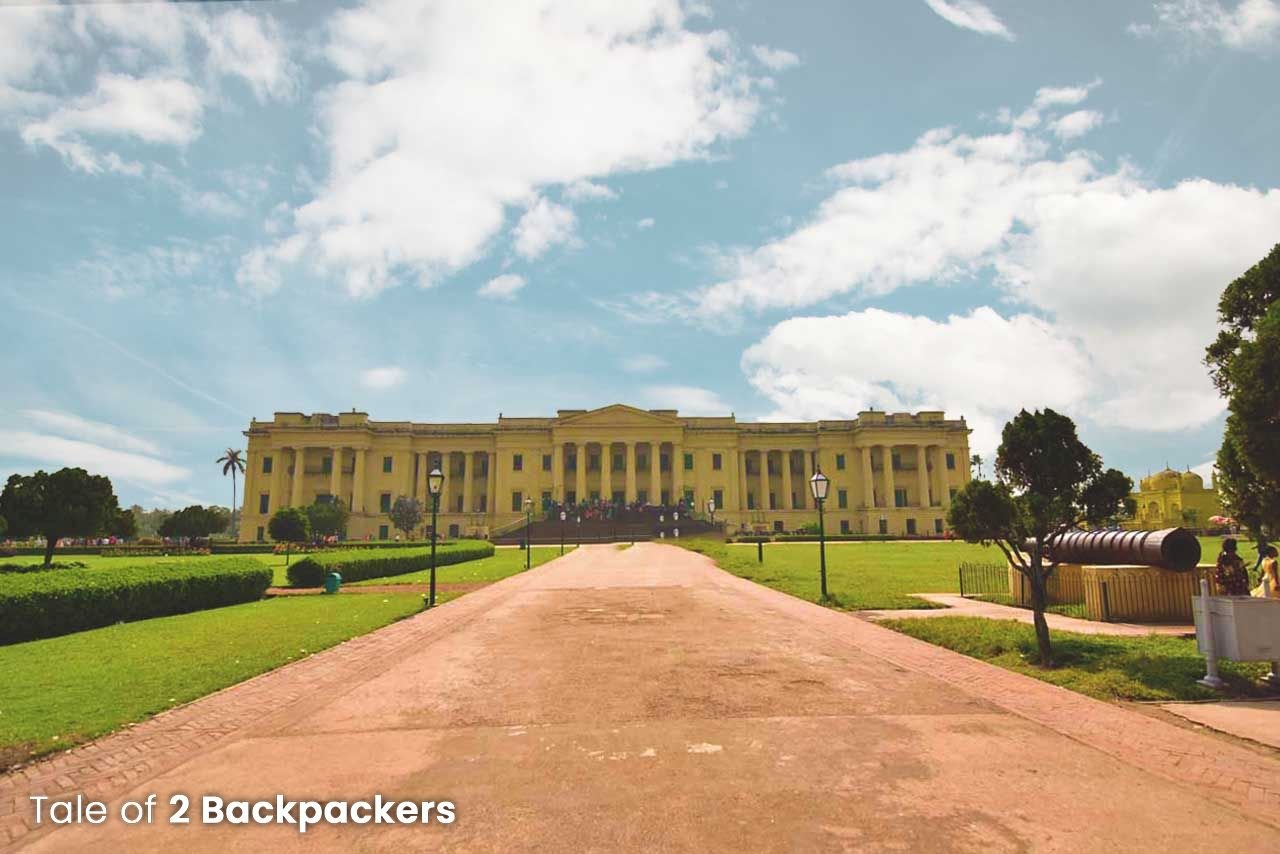
A brief history of Murshidabad | The story of a Brahmin who went on to become the Nawab
Murshidabad’s tryst with history starts in the early eighteenth century. Murshidabad was originally a nondescript village named Maksudabad before Murshid Quli Khan set his eyes upon this land to make it the capital of Bengal province. The life story of the Nawab is quite interesting. It is said that Murshid Quli Khan was born a Brahmin in the Deccan region. Due to penury, he was sold as a slave to Haji Shafi Isfahani, a Persian merchant from Iran. Isfahani rechristened him as Mirza Hadi and provided him an education. After returning to India, Mirza Hadi joined the services of the Mughals. His active role in the army of Aurangzeb earned him brownie points. So when the Mughal Emperor Aurangzeb was looking for a Diwan in Bengal at Dacca, Hadi was his automatic choice. By this time he also came to be known as Kartalab Khan.
Later Kartalab Khan went into a confrontation with Azim-ush-Shan, the grandson of Aurangzeb. In this scenario, Kartalab Khan relocated his office from Dacca to Maksudabad on the banks of Bhagirathi. His logic was that the place was situated in the central part of Bengal and it would be easier to communicate throughout the province. Aurangzeb was happy with the revenue that Kartalab Khan gave him and awarded him the title of Murshid Quli among others. Consequently, he changed the name of Maksudabad to Murshidabad in 1704. Later Murshid Quli Khan declared himself the Nawab of Bengal and thus became the first independent Nawab of the province. At that time, Bengal province consisted of present-day Bengal, Bihar, Odisha and Jharkhand.

Murshidabad was one of the most prominent cities of Bengal. It was rich in natural resources, trade and commerce flowed and was prosperous. Most of the European traders like the British, French, Portuguese and Armenians had settled around these areas for business. Affluent businessmen from Rajasthan came and settled down in Murshidabad. Later these Jain merchants formed the Sheherwali community and many of them became the bankers to the Nawab. While Murshid Quli Khan became the first Nawab, Manik Chand became his personal banker. Mughal Emperor Farrukhsiyar, after ascending the throne of Delhi in 1712, honoured Manik Chand with the title of Nagar Seth (Banker of the city). Murshidabad rolled in riches.
It was in 1757, that Nawab Siraj-ud-daula, the grandson of Alivardi Khan was defeated by Robert Clive of the British East India Company in the Battle of Plassey. It is believed that the Nawab was betrayed by his own people leading to his defeat. The glory and sheen of Murshidabad gradually diminished, but the ruins of the glorious past still remain. A trip to Murshidabad to visit Hazarduari and the other attractions is quite common among the Bengalis. But I would also suggest everyone who visits West Bengal to take a trip to Murshidabad and enjoy its regal beauty.
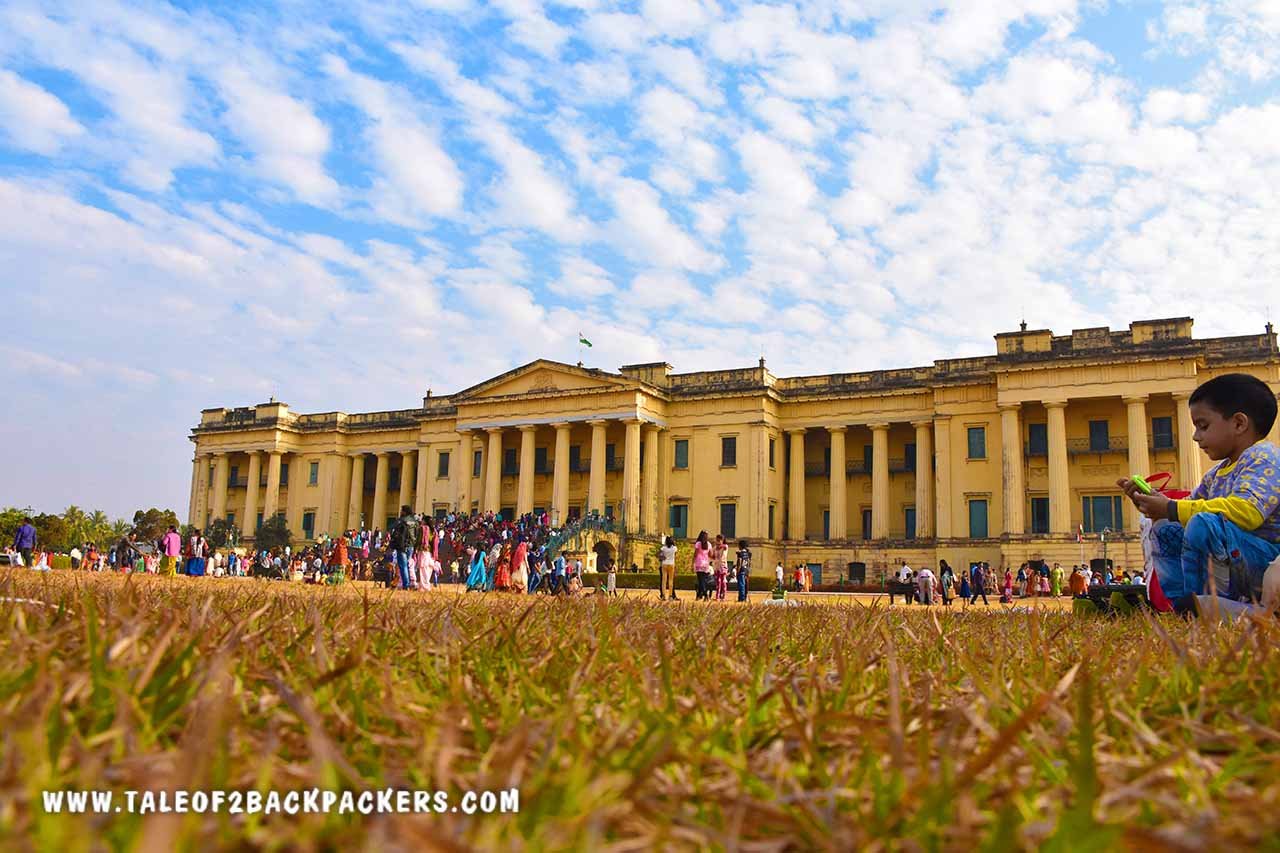
Places to visit in Murshidabad
Murshidabad is located beside the Bhagirathi River. Tourism in Murshidabad thus can be divided into two parts – one on the eastern bank of the river and the other on the western bank. While Azimganj and Khosh Bagh lie on the western bank, Lalbag area, Nasipur, Jiaganj and Cossimbazar lie on the eastern bank of Bhagirathi. You can plan your Murshidabad trip accordingly. Let us first write about the places to visit in Murshidabad.
-
Hazarduari Palace
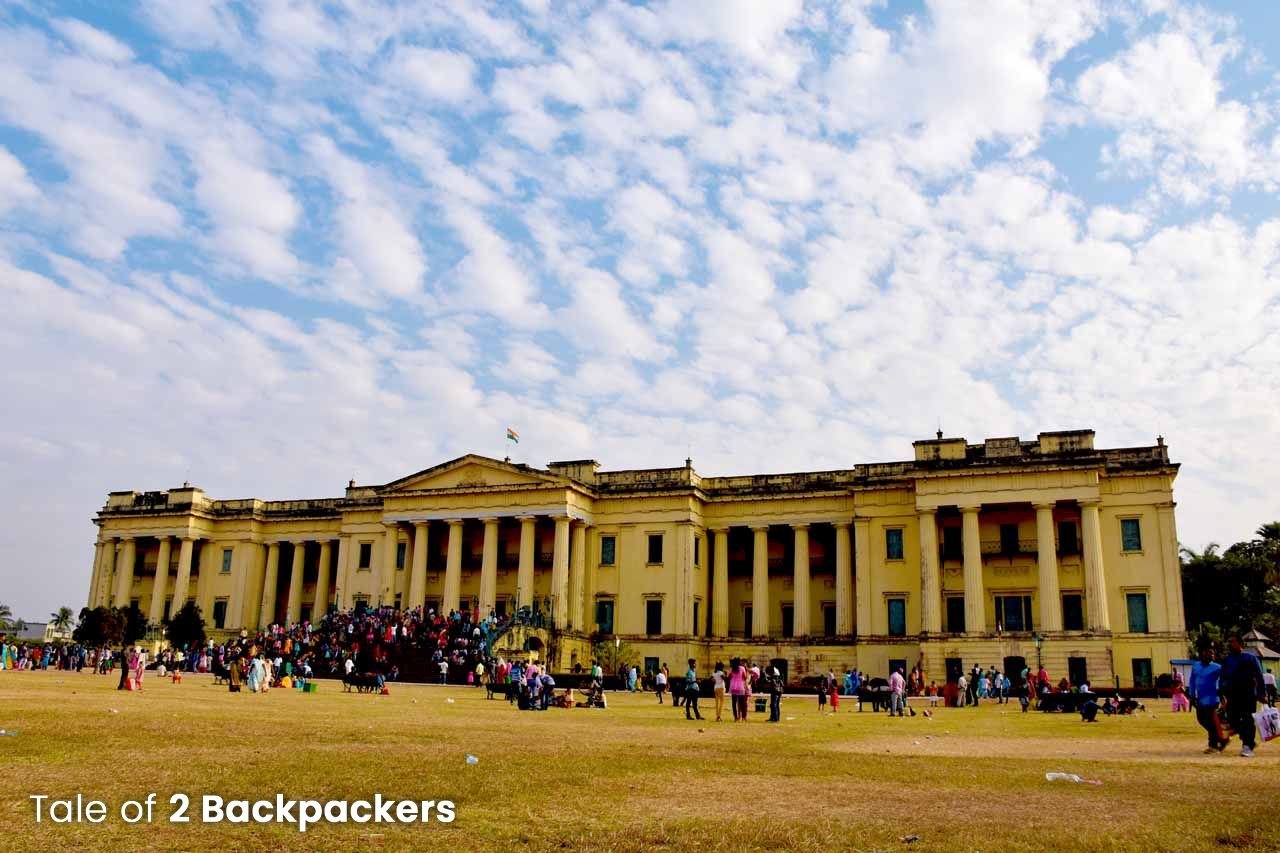
Hazarduari in Murshidabad is undoubtedly the most iconic attraction in Murshidabad. The grand yellow structure is located right beside the Bhagirathi River. Although Murshidabad is known for both Nawab Siraj-ud-Daula and Hazarduari, the palace has nothing to do with the Nawab. Hazarduari was built by Humayun Jah during the period 1829-1837 at the site of the old fort known as Nizamat Qila (fort). Architect Duncan Mc Leod was the mastermind behind this grand building. Hazarduari is the best example of Indo Italian architecture having huge pillars, a grand flight of stairs, beautiful statues and lamp posts. Nawab Humayun Jah is believed to have spent a whopping 18 Lakh Rupees (during that time) for building his palace.

The palace has now been converted into a museum having a great collection of antiques, arms, weapons and some invaluable paintings of various European artists. Other interesting things include old costumes and jewellery, palanquins, ivory howdahs and palanquins, magnificent chandeliers and even some rare books, old maps and manuscripts. All the artefacts in the museum are no doubt wonderful, but the most impressive one is the grand chandelier with 96 lamps placed in the Durbar Hall. There is also a silver throne with a grand umbrella inside the Hall.
Hazarduari literally means the place of thousand doors (Hazar means thousand and duar means doors). The palace is said to have a thousand doors. However, only 900 of them are real and 100 are fake. You will probably require an hour or so to explore the Hazarduari Palace and its museum. And if you are fond of antiques and history, you might take more time. The Hazarduari complex also consists of the Clock Tower, Bacchewali Tope, Madina mosque and the Nizamat Imambara lies just opposite Hazarduari.
Hazarduari, Murshidabad Opening Time: 9AM to 5 PM.
Entry Fees: To enter the museum, you have to pay an entry fee. The entry fees of Hazarduari Palace and Museum is Rs5 for Indians and Rs200 for foreign nationals.
-
Nizamat Imambara
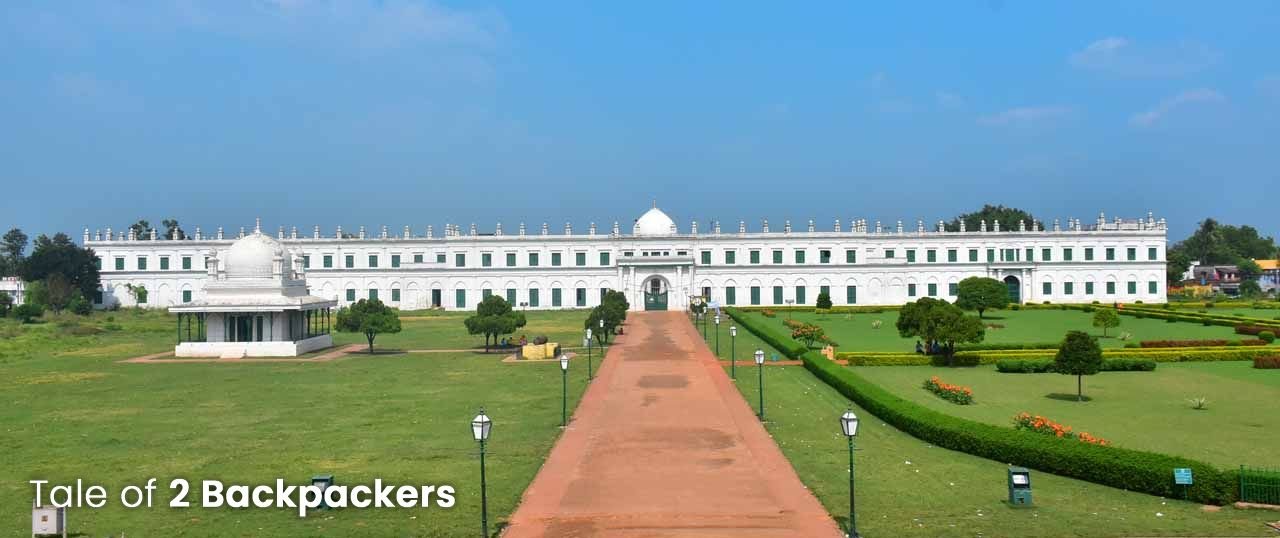
Right opposite to the yellow building of Hazarduari Palace stands the impressive Nizamat Imambara. The white structure looks absolutely gorgeous against the blue sky. Look at the pictures if you do not believe me.
The present Imambara was built in 1847 by Nawab Nazim Mansoor Ali Khan Feradun Jah after the original wooden Imambara built by Nawab Siraj-ud-Daula was destroyed by fire. The Imambara is 680 feet long and the central block is about 300 feet in width. The Nizamat Imambara is the largest one in Bengal and one of the largest in India.
Unfortunately, entry to the Nizamat Imambara is usually not allowed. The Imambara remains open to visitors only for 10 days during Muharram.
-
Clock Tower

This huge yellow tower used to be known as the “Big Ben” of Murshidabad. The tower was designed by Sagar Mistri, assistant to Duncan Mc Leod and like the Big Ben of London, the dials of the clock could be seen from a long distance and also from the other side of the Bhagirathi River. The tower has a heavy bell on top.
-
Madina Masjid
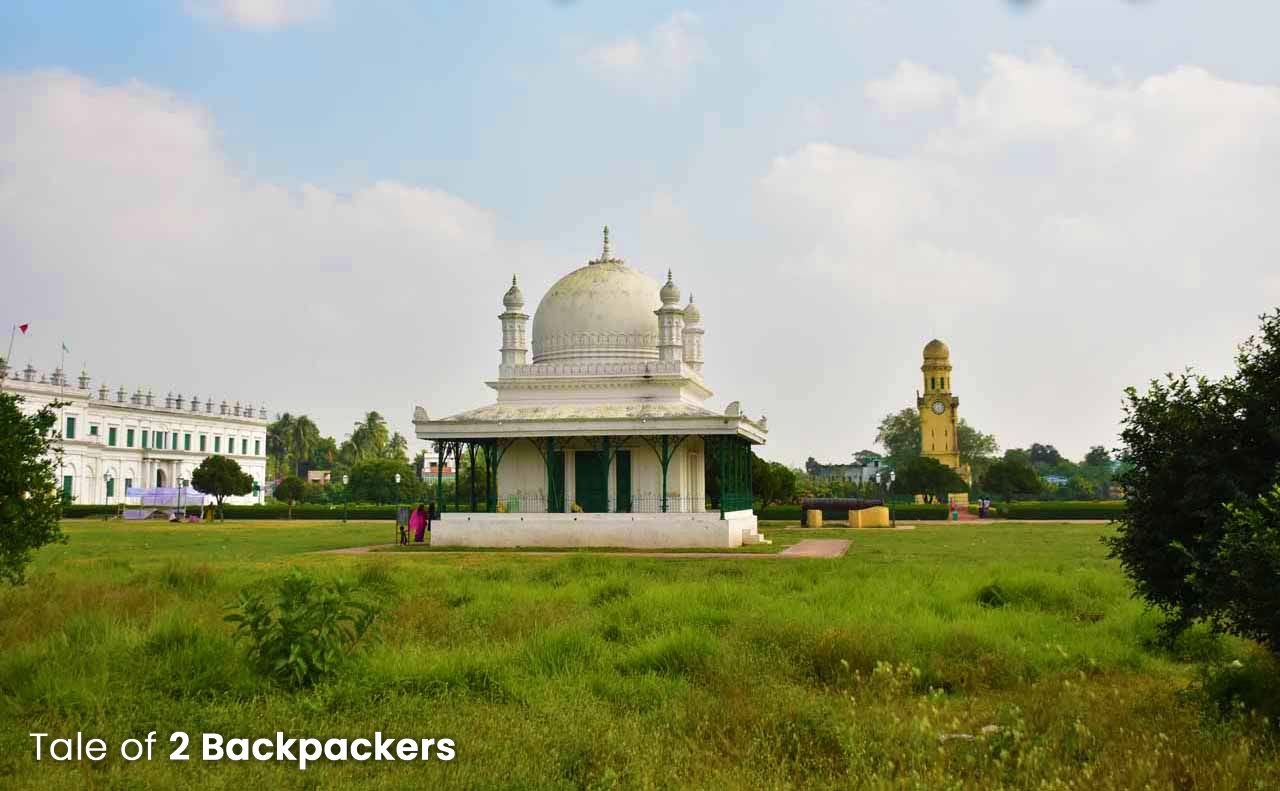
The only remains of the original Nizamat Imambara is the Madina Masjid located just in front of the Imambara. According to the book “A History of Murshidabad District” by Major J. H. Tull Walsh, it is said that Nawab Siraj-ud-Daula personally brought bricks and mortar and erected the foundation of the Imambara building. In the middle of the Imambara, the Medina was constructed. The plot of land on which the Medina was built was dug out and refilled with the sacred earth brought from Mecca. When you visit the Hazarduari complex, the guide will tell you that Nawab Siraj himself went to Mecca to bring the sacred earth. Well, this fact is not yet corroborated.
-
Bacchawali Tope
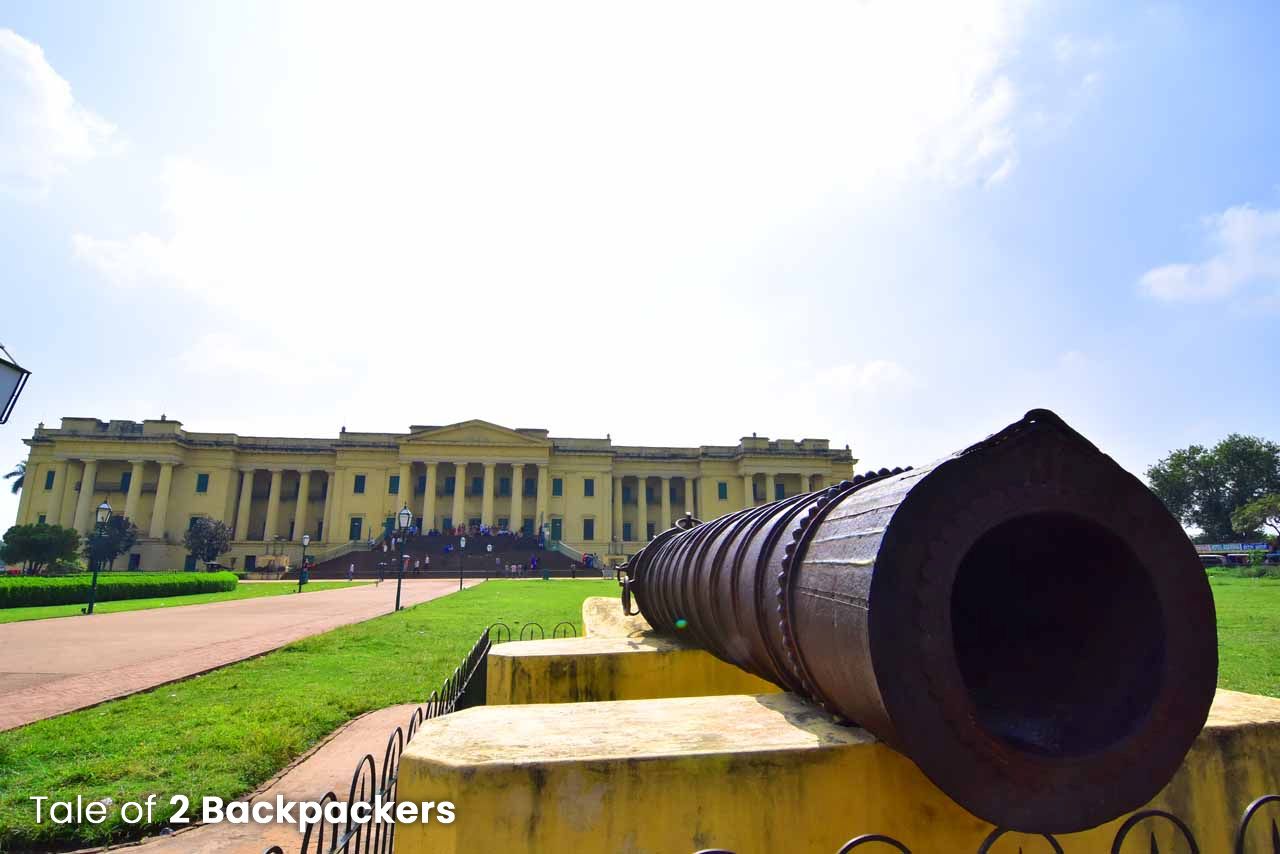
The cannon is placed in the Nizamat Fort Campus between the Nizamat Imambara and the Hazarduari Palace and just beside the Madina Masjid. The cannon is said to have been built between 12th and 14th century AD and weighs 7657 kg. it is said that the cannon was fired only once. When it was fired, it produced such deafening noise, that al the pregnant women in the vicinity of 10 miles radius had a miscarriage! The cannon was never used since. The name Bacchawali Tope also comes because of this (Baccha means child and tope means cannon).
-
Katra Masjid

The Katra Masjid is perhaps one of the oldest standing structures in Murshidabad. It was built by Nawab Murshid Quli Khan between 1723 and 1724. The Katra Mosque was a great centre for Islamic learning. As you enter the Katra Mosque, you will see 2 towers on either side. There were actually 4 of them on the four corners, but the other 2 got destroyed in the earthquake of 1897. There were a flight of stairs through which one could get to the top of the tower. But now the gates have been closed.
Between the two towers, you will find small cells. These cells are found in 2 stories surrounding the mosque. It is said that these are the cells were used to house the scholars who had come there for Islamic learning. There are as many as 700 cells surrounding the structure.
The next interesting structure is the mosque itself. There are 5 doors to the Katra Masjid. There are triple Mihrabs on the walls of the mosque facing the doors. Mihrab indicates a semicircular niche in the wall of a mosque. It indicates the direction of Kabba in Mecca. Muslims pray looking at this direction.

On top of the central Mihrab, there is an Arabic inscription. There is a small flight of stairs leading to a small platform at the central Mihrab. This is the platform where sermons and speeches are usually given. This is quite same as the one we had seen at Adina mosque in Malda. There the platform was much higher though.
At the outer walls of the mosque, there is a basalt slab that has some Persian inscription written on it. In front of the mosque is the huge praying area. It is said that the praying area could accommodate 2000 Namaz readers. You can actually see the floor of the praying area is divided into squares. It is said that there are 2000 squares, each one for a Namaz reader. There are also a few hooks on the mosque wall and a few rings on the floor of the prayer area. Our guide told us that the hooks and rings were used for tying huge clothes so that they could serve as a canopy over the Namaz readers during the sun and heat.

This is not the end of the Katra mosque. This place also houses the tomb of Nawab Murshid Quli Khan. The current entrance to the mosque is actually the back entrance. The original entrance to the mosque now lies on the backside (the eastern side). There is a flight of fourteen stairs to enter the mosque. Under the stairs lies the tomb of Nawab Murshid Quli Khan. It is said that the Nawab at the end of his days felt remorse for all the bad deeds he had done during his lifetime. So he desired to be buried under the stairs of the Katra Masjid so that the dust from the feet of noblemen would fall on his grave. This would be a way to atone for the sins he had committed.

Although Murshidabad is known mostly for Hazarduari, it is the Katra Masjid that we found most interesting. The structure, architecture and the stories of Nawab Murshid Quli Khan were quite engrossing. Hazarduari in Murshidabad is no doubt iconic, but it is the Katra Masjid that had my heart!
-
Fauti Masjid

Fauti or Fouti Masjid is another impressive structure in Murshidabad. It is a huge structure, but in a state of decay overgrown with vegetation. The mosque was built in 1740 by Nawab Sarfaraz Khan, the grandson of Nawab Murshid Quli Khan, but was never completed. The mosque is located near a railway crossing about a km from Hazarduari in Murshidabad. There are a couple of interesting stories surrounding the mosque.
The Fauti Masjid is an incomplete work. Only 2 out of the 5 domes were constructed. The rest were never made. Also, nobody has read Namaz in the mosque. It is said to be a failed mission of Nawab Sarfaraz Khan. Historically, Nawab Sarfaraz Khan died of a gunshot against Alivardi Khan in the Battle of Giria in 1740, the same year that the mosque was built. After his death, the building of the mosque stopped.
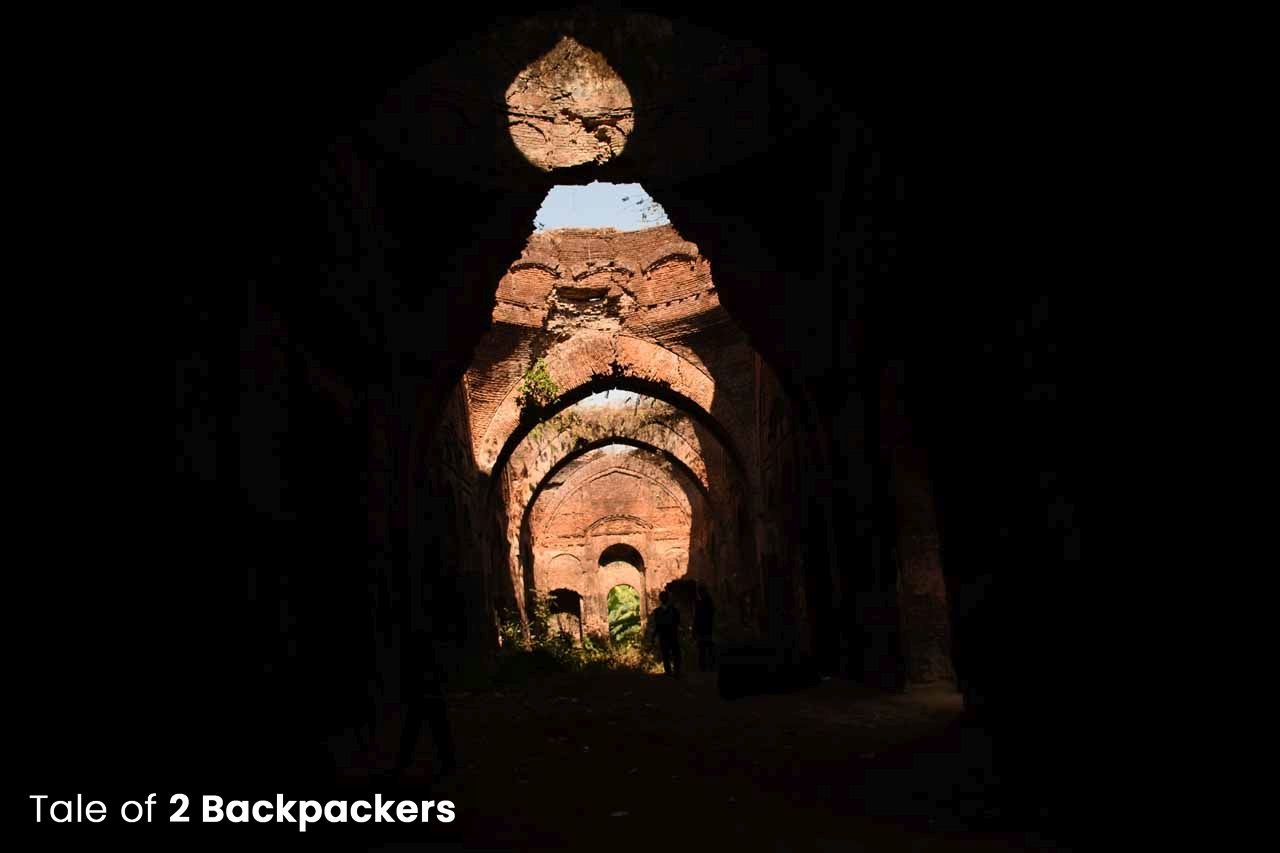
There is another interesting story about the death of the Nawab that is more of a local legend. It is said that the Nawab died on the battlefield not by a gunshot, but by lightning. According to the legend, lightning struck the mosque as well when he died on the battlefield. That created a big crack in the dome. The mosque was thus considered unlucky and the work was completely abandoned. Well, actually, the work of building the mosque stopped after the death of the Nawab mostly because of lack of funds. The story of lightning is perhaps the interesting stories made up to astonish people.
There is a third story as well which is told more as fascinating folklore. It is said that the Nawab had commissioned building the mosque in a single day. The work could not be completed by the masons and thus was abandoned. This story is so silly that even the guides nowadays tell us that this is not true!!
Anyways, Fauti Masjid is an impressive structure. At first sight, it looks just like any dilapidated structure. But once you go inside, you will find it to be quite grand. A small flight of broken stairs lead inside the mosque. There are 5 entrances and 4 attached towers. As we said before, only two domes were completed. Well, if you decide to climb the stairs, be careful. It is broken and slippery and I am sure you would not like to fall down from there.
We found the incomplete and decaying structure to be so interesting. We wondered how the complete structure would actually look! It would undoubtedly be quite a feat if the construction were completed!
-
Jahan Kosha Cannon
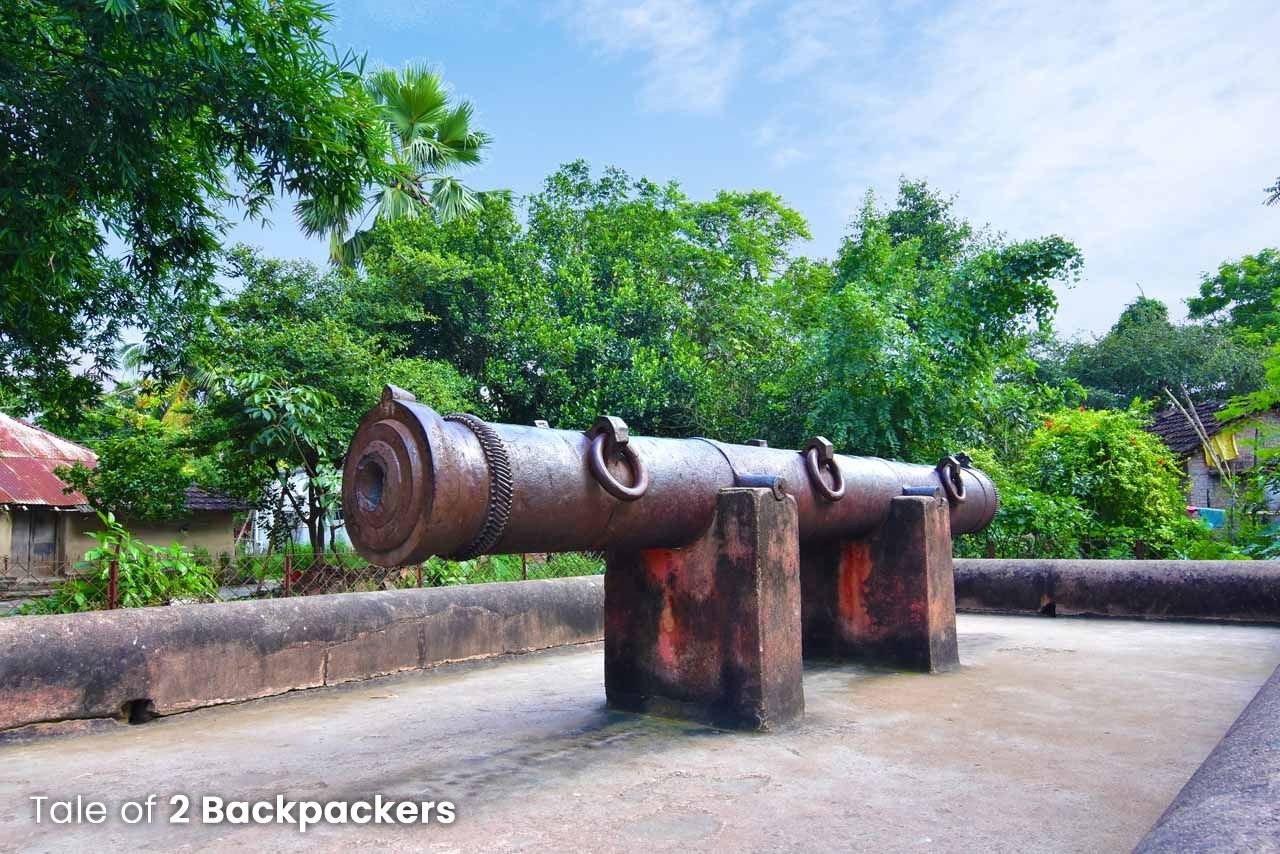
The Jahankosha Cannon lies just near the Katra mosque. Placed on a pedestal, the huge cannon weighs 8000 kg, 17.5 feet long and made of 8 metals. About 17 kg of gunpowder was used for a single shot. No wonder, it was known as Jahankosha (destroyer of the world). The area where the cannon is now placed was used to be known as the Topekhana or armoury. The cannon was made by gunsmith Janardan Karmakar of Dacca in 1637. Nawab Murshid Quli Khan bought the cannon from Dacca to Murshidabad when he shifted his capital.
-
Tripaulia Gate
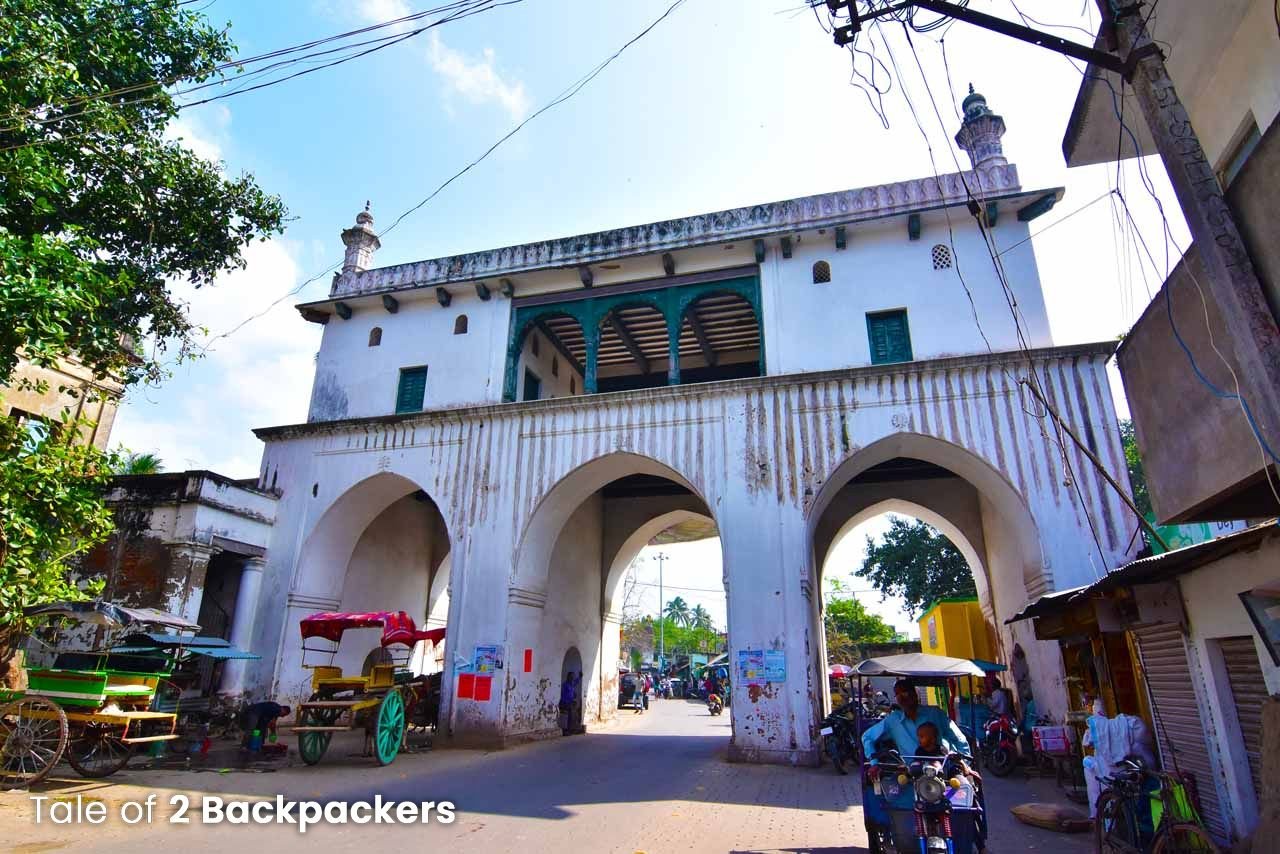
The Tripaulia Gate was one of the entrances to the Nizamat Kila (fort) area of Murshidabad. It now stands as a white gate with a Nahabatkahana at the top. It is said the Nawabs used to enter the Kila area with their horses through the Tripaulia Gate. Earlier, the gate was known as Chawk Gate. The Chawk Masjid is just a few metres beside the gate. The Tripaulia Gate was built by Nawab Shuja Khan, the successor of Nawab Murshid Quli Khan.
-
Kathgola Gardens and Palace

Kathgola Gardens is a sprawling area of gardens, palaces and temples in the heart of Murshidabad, just like an oasis in the middle of the busy town. The complex was built by Rai Bahadur Laxmipat Singh Dugar, one of the leading bankers and zamindars of the early nineteenth century. Well, the garden does not have anything to do with warehouse for timber as the name suggests (kathgola means timber warehouse). The name has come from “Kath Golap” that means wood rose. Earlier many varieties of wood rose were grown in the garden and hence the name was Kath Golap Gardens.
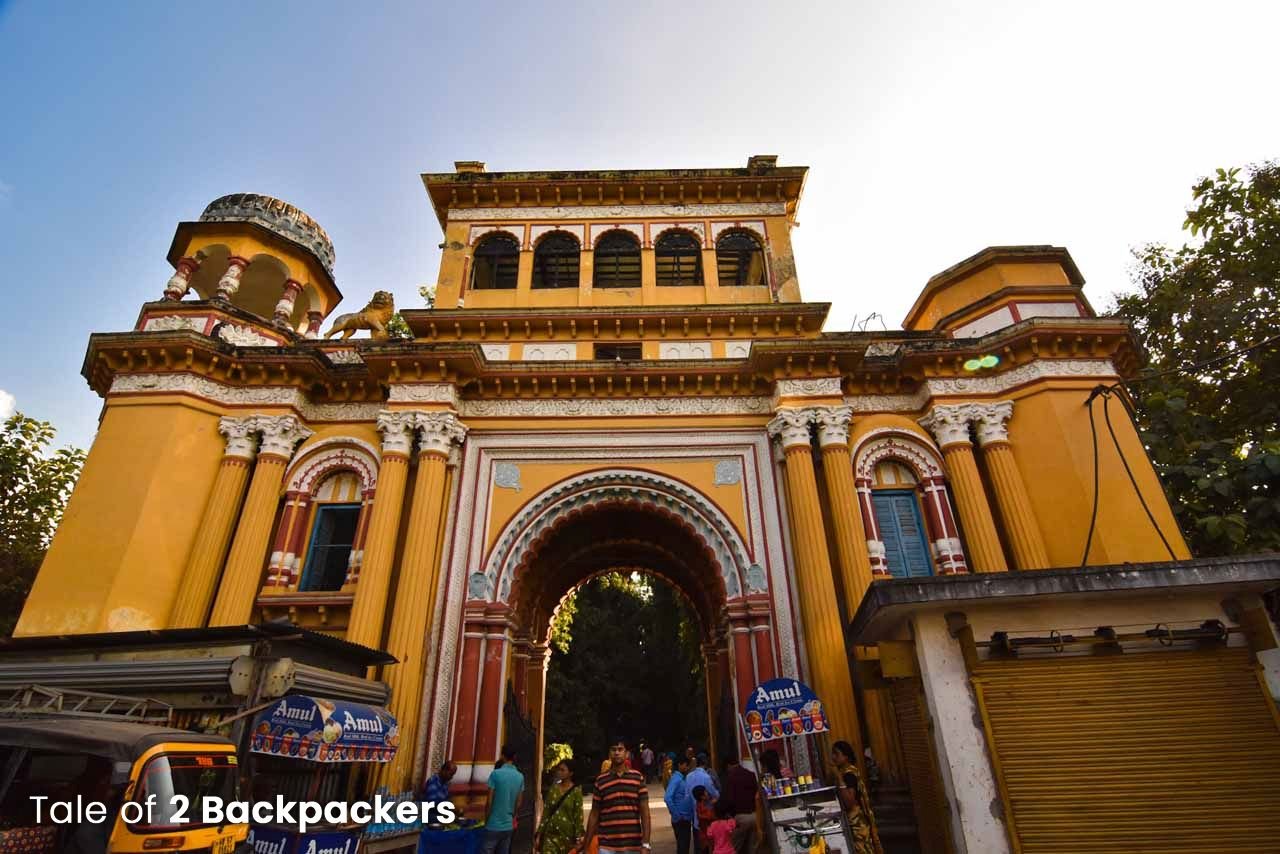
The entrance of Kathgola itself is huge and quite impressive. Yellow in colour, the entrance has huge Corinthian pillars, stucco floral designs and a Nahabatkhana adorned with beautiful stained glass. Once you enter the gate, you will come across the huge garden that mainly has mango trees. If you look around, you will see 2 statues of a person on horseback on either side of the pathway. The statues are probably of the Dugar brothers. The entry ticket gate is next.
After you enter the premises, the first thing that will come is the Baoli on your left. The Baoli was once in a very bad state, but now it has been renovated. Well, this is just a stepwell and not any secret passage as a few guides will claim. There is a statue of a lion and a marble statue of a man. On the right, you will find a zoo. It was once a private zoo, but now it has lost its sheen. We did not visit the zoo.

Next, comes the grand 3-storied mansion with a pond in front. Go to the other side of the water body and you will get beautiful pictures of the mansion and its reflection on the water. This mansion is also a beautiful example of fusion architecture that was so prevalent during those times. The mansion has now been converted to a museum and houses marble statues, huge chandeliers, Italian marbles, porcelain artefacts, old rosewood furniture, Belgian mirrors, paintings and other antiques. Photography is not allowed inside the mansion just like that in Hazaduari.
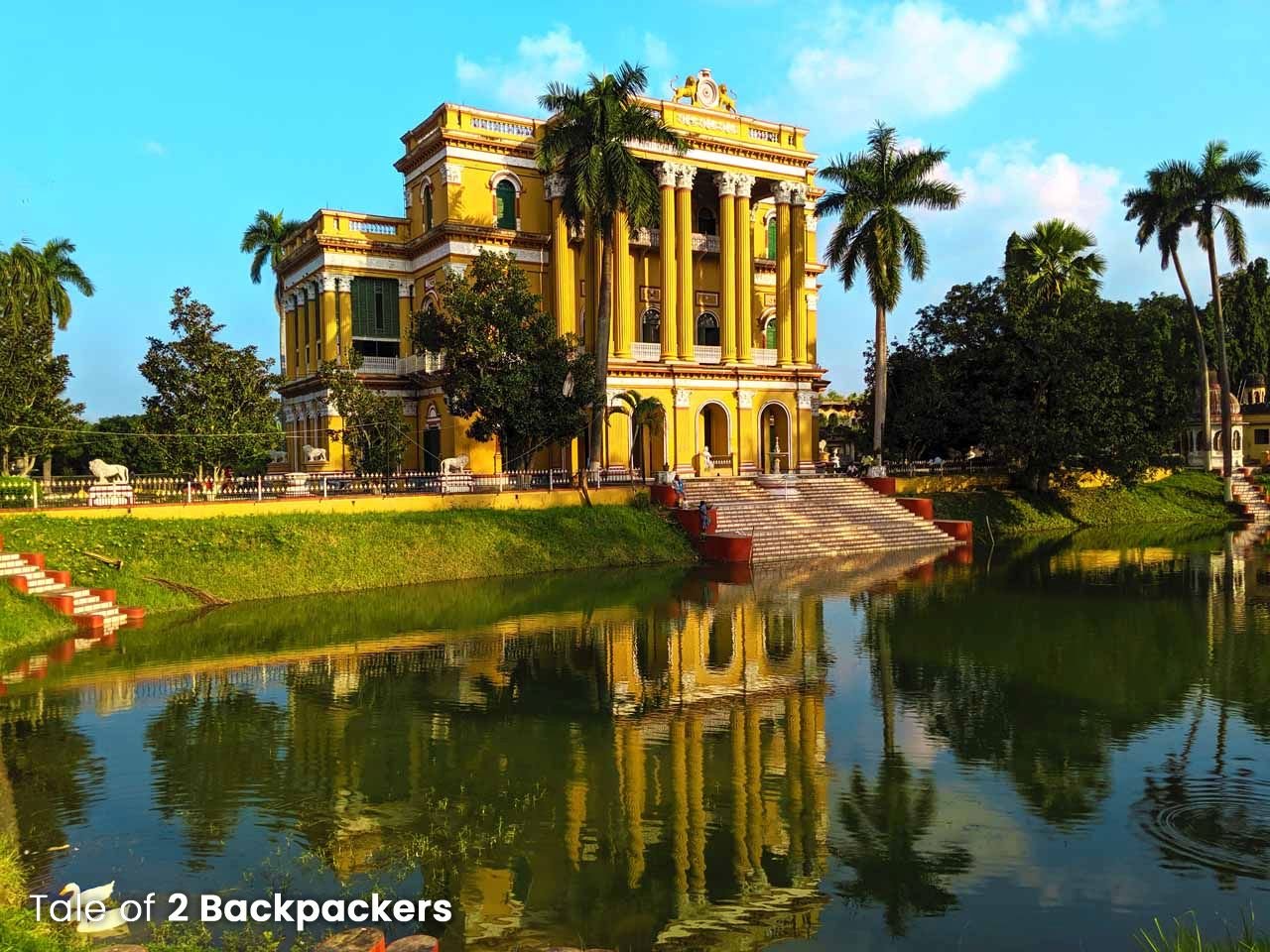

Just close to the yellow mansion, another dilapidated building is standing. This one used to be the Zenana Mahal or the women’s quarters. If you walk down a little, the beautiful Adinath Temple dedicated to the first Jain Tirthankara is located at one end of the garden. The temple was built in 1933, while the idol is said to be almost 900 years old. There is a water body in front of the temple where you can do boating.
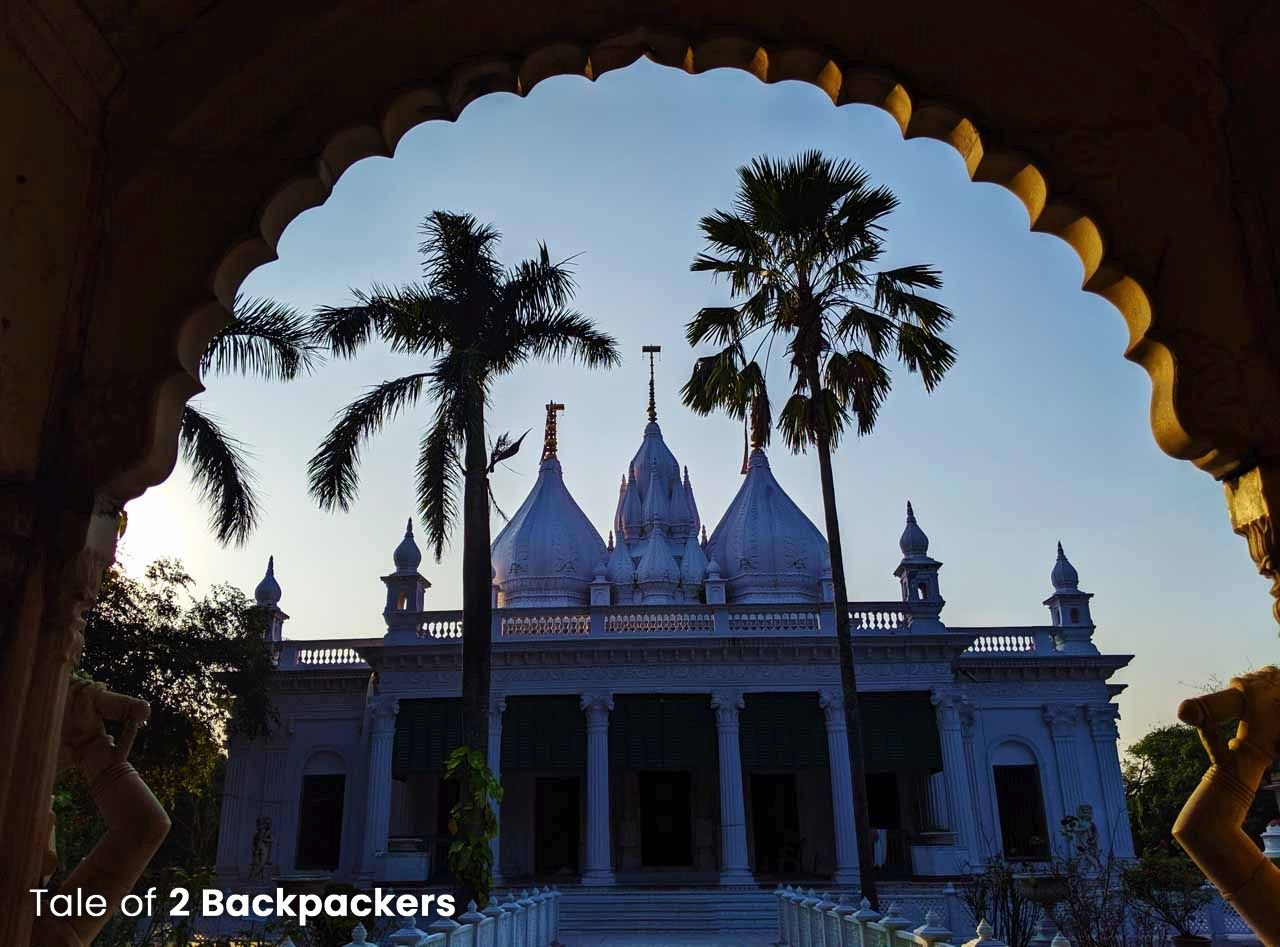
Ticket Price: Rs10/-
Kathgola Gardens is a huge complex. Be ready to walk around a bit. I would suggest you to wear comfortable shoes for visiting these places.
-
House of Jagat Seth & Pareshnath Temple
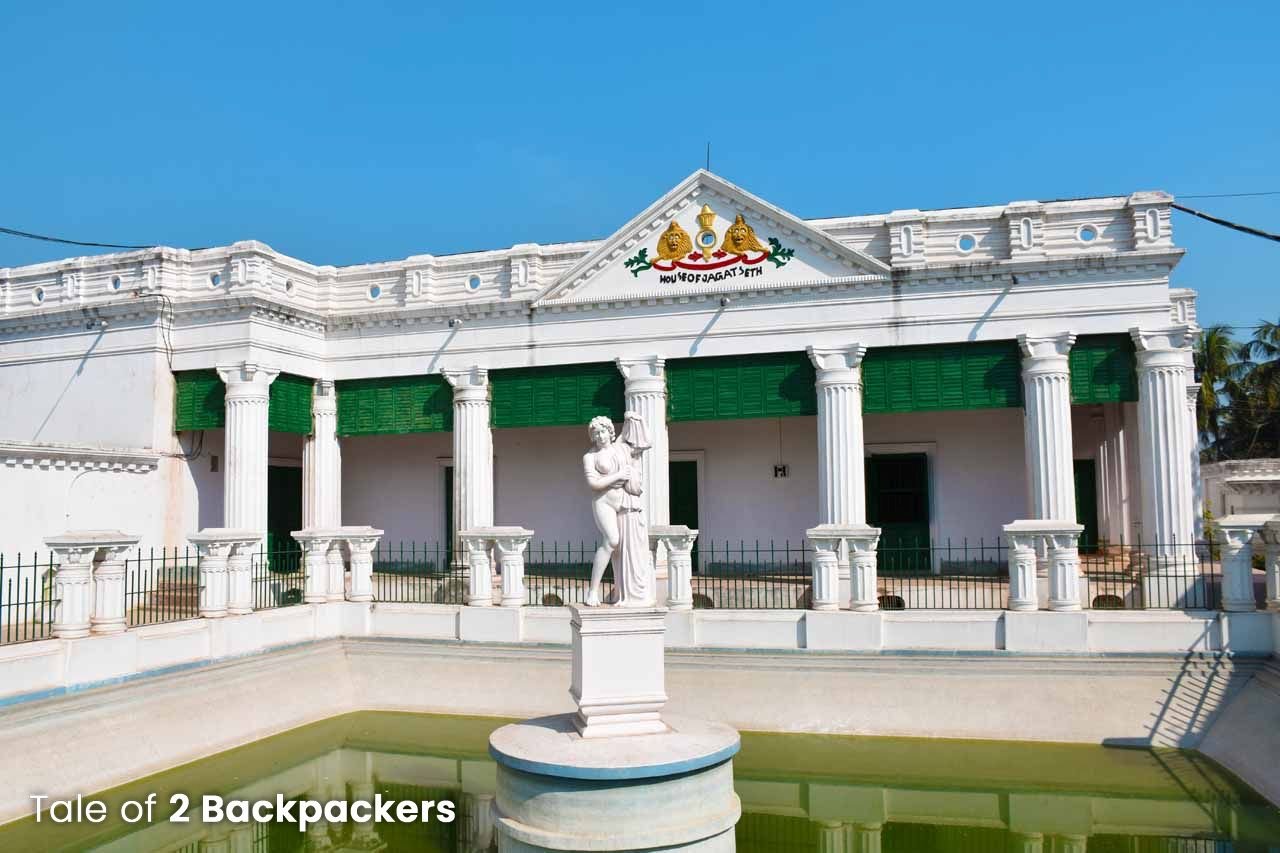
Jagat Seth was the title given to the insanely rich businessmen of the area who were also the financers to the Nawab and other zamindars. It was the title given to the descendants of Manik Chand, who had come to Murshidabad from Rajasthan for business. In 1715, Mughal emperor Farrukhsiyar conferred the title of “ Nagar Seth (Banker of the city)” to Manik Chand.
After the death of Manik Chand, his nephew Fateh Chand became his successor and achieved much success. Fateh Chand was given the title “Jagat Seth” (banker of the world) by Mughal emperor Mohammad Shah in 1723.
After Fateh Chand his grandson Mahtab Chand succeeded to the title in 1744. His cousin Swarup Chand was given the title of “Raja”. Both of them were the biggest financiers of that period. They were instrumental in the defeat of Siraj-ud-Daula in the Battle of Plassey.
Jagat Seths were said to be the pioneer in banking in India. There are many stories about the riches of the Jagat Seths. They not only financed the Nawab, but also the Europeans and other feudal lords.
There is an interesting saying about the wealth of Jagat Seth. It was believed that if their wealth were poured into River Bhagirathi, the river would be blocked by the immense treasure of Jagat Seth! Roben Orme, the official historian of the British East India Company described Jagat Seth as the greatest banker and money changer known in the world at that time.
The present building that is now known as the House of Jagat Seth was perhaps their banking premises. The original house has been devoured by the changing flow of the Bhagirathi River. The house has now been converted into a museum. Here too, you can get a guided tour of the museum where you can see antique furniture, coins, utensils and old dresses.
There is Pareshnath Temple at the premises of the house of Jagat Seth.
-
Tomb & Mosque of Azimunnisa Begum
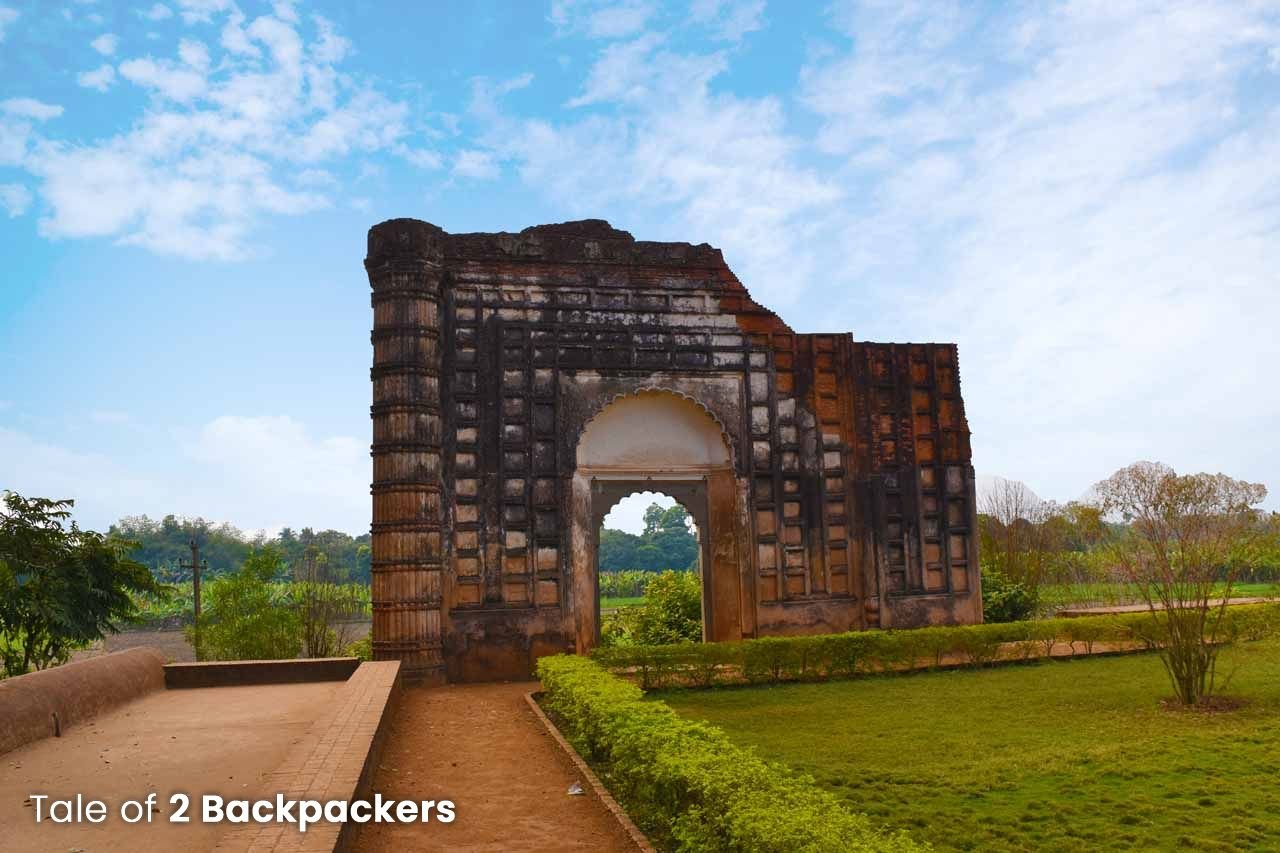
Well, Azimunnisa Begum has a gory history. We found the place to be very beautiful, but the story was a bit difficult to digest. Begum Azimunnisa was the daughter of Nawab Murshid Quli Khan and was believed to be a nymphomaniac. That we don’t have a problem with, but the story goes on to say that she used to eat the livers of children. The Begum once had a life-threatening disease. She was advised to eat the livers of freshly slaughtered children as a remedy. She did so and got well, but this became an unhealthy habit for the Begum. She did not stop having livers (Kalija) of children. She was thus known as Kalija-Khaki Begum. She was later buried alive because of her misdeeds.
We actually do not know whether or not to believe the story. We leave it to you to decide. But the tomb of Begum Azimunnisa is located below the entrance stairs, just like that of her father, Nawab Murshid Quli Khan.
-
Namak Haram Deori

Namak Haram Deori is actually the dilapidated gate of Mir Jafar’s palace. Nothing much remains of the palace now. It is believed that it is under this gate that Mir Jafar’s son Miran stabbed Siraj-ud-Daula to death. There is another saying that Siraj was actually killed at Hira Jheel Palace. The Hira Jheel Palace was also totally destroyed after the death of Nawab Siraj-ud-Daula.
According to popular belief, Nawab Siraj-ud-Daula was betrayed by his own relatives and men and so he lost to Robert Clive despite having more military strength than the British. Mir Jafar betrayed the Nawab. Henceforth, the gate of his palace came to be known as Namak Haram Deori or Traitor’s Gate.
-
Jafarganj Cemetery

Adjacent to the Namak Haram Deori is the Jafarganj Cemetary. The graves of the family of Mir Jafar lies in this cemetery. The cemetery has the graves of Mir Jafar, his wives, his son Miran and his other family members. The grave of Humayun Jah is also located here. Interestingly, the graves of the women are enclosed within the walls. In death also the women remained pardahnashin (inside the veil).

If you walk through the cemetery, you might come across some interesting white and blue coloured tiles. These ceramic tiles are on the floor and mainly depict the lifestyle of the British.
-
Nasipur Palace
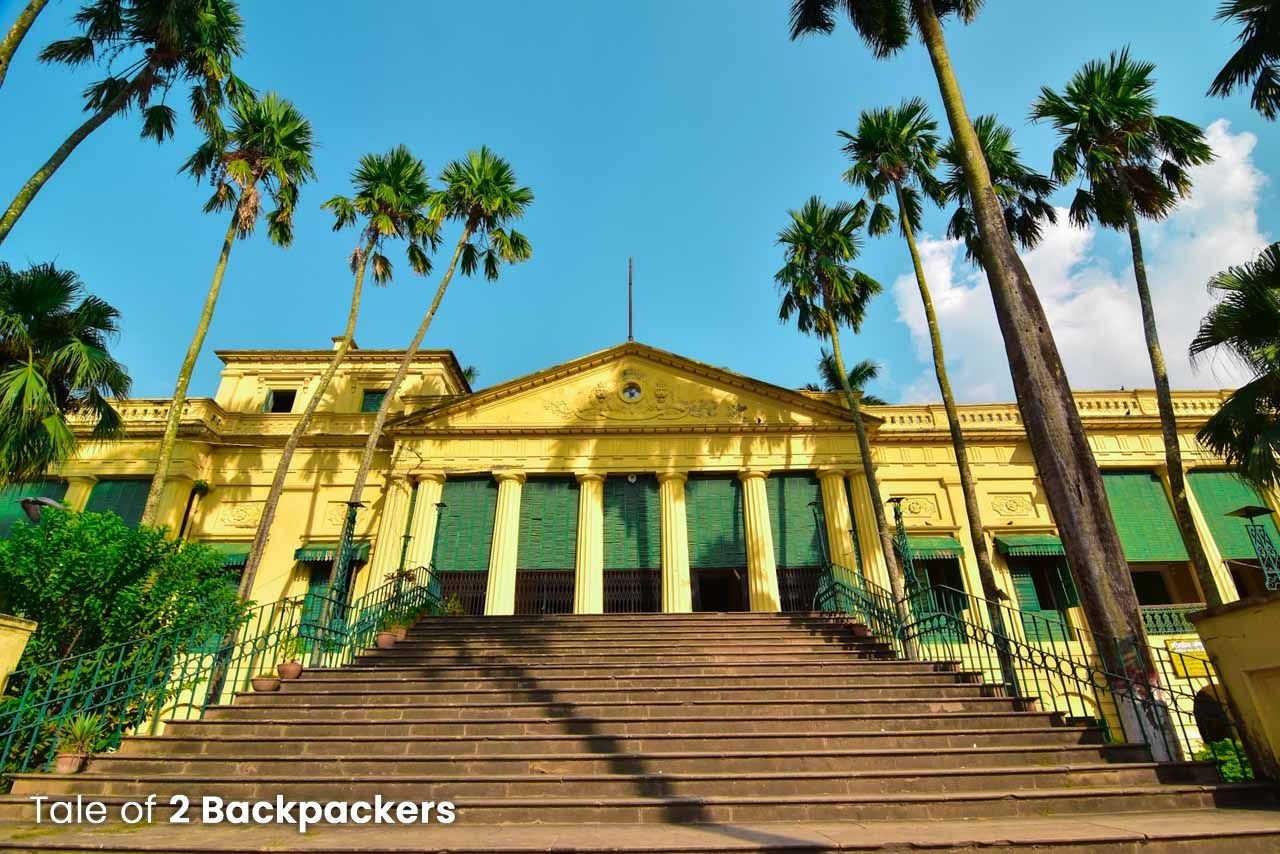
Nasipur Palace is clearly the lookalike of Hazarduari in Murshidabad. Nasipur Rajbari was the property of Debi Singh, who had arrived from Panipat to Murshidabad for trading. Gradually he became the tax collector for the British and was said to be the most stone-hearted and sadistic feudal lord of his time. If taxes were unpaid, he used to hang the people to death, which is quite an extreme form of punishment.
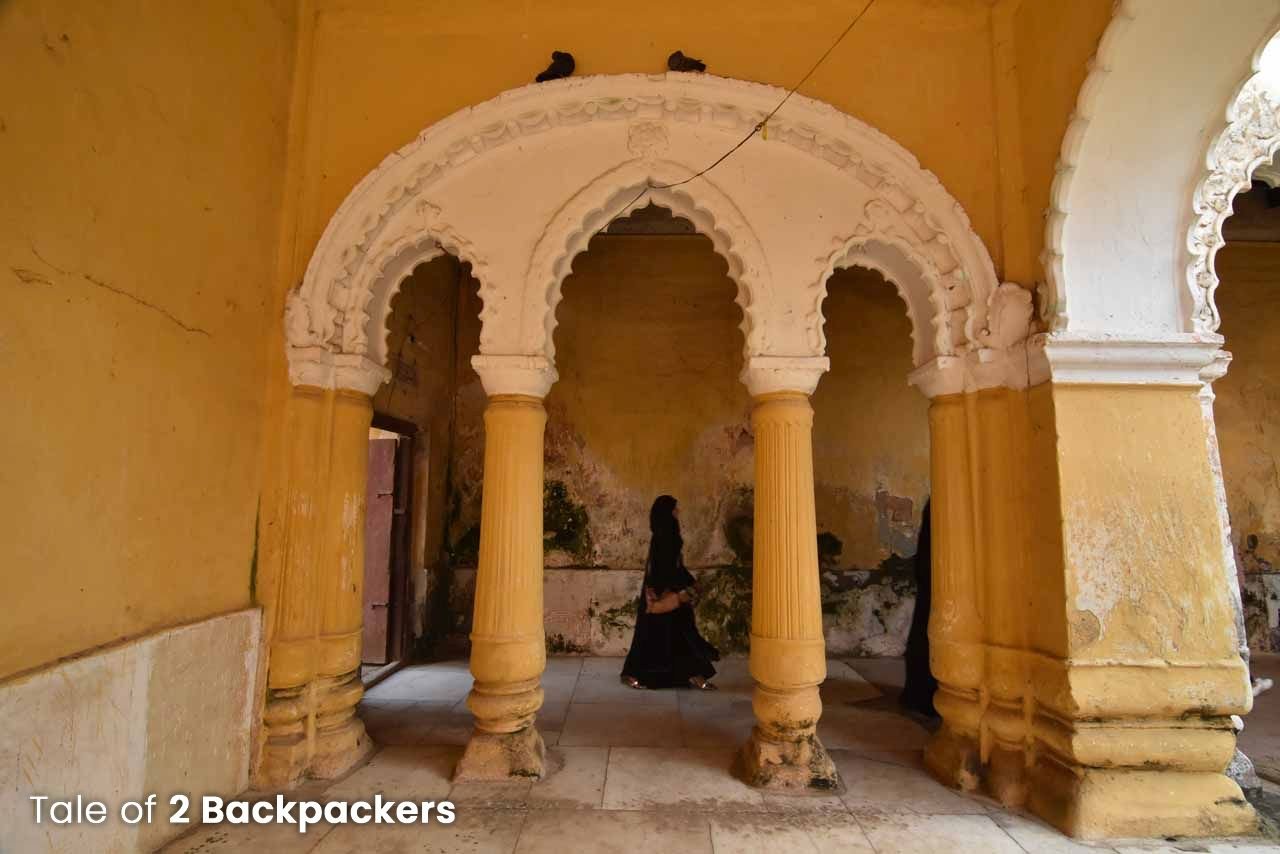
The house was initially in a bad state, but now it has been renovated and turned into a museum. There are 2 storeys with a flight of staircase and an imposing façade. The yellow building with green doors, windows and façade look quite beautiful from a distance. The Nasipur Rajbari has a temple located inside, a nat mandir and long corridors.
At Nasipur Rajbari, you will invariably come across the pictures of Hirabai. She was the dream girl of the eighteenth century. Tall and elegant, Hirabai used to be the main attraction of the parties thrown by Debi Singh.
-
Wasif Manzil
Wasif Manzil is a beautiful palatial structure built by Nawab Wasif Ali Mirza as his residential mansion. It is located between the Hazarduari Palace and the South gate of the Nizamat Fort campus. The original palace was destroyed during the earthquake of 1897 and was later rebuilt in 1904. The palace has some rare artefacts but was lying in utter neglect. Recently, the place has been renovated and turned into a museum.
-
Motijheel
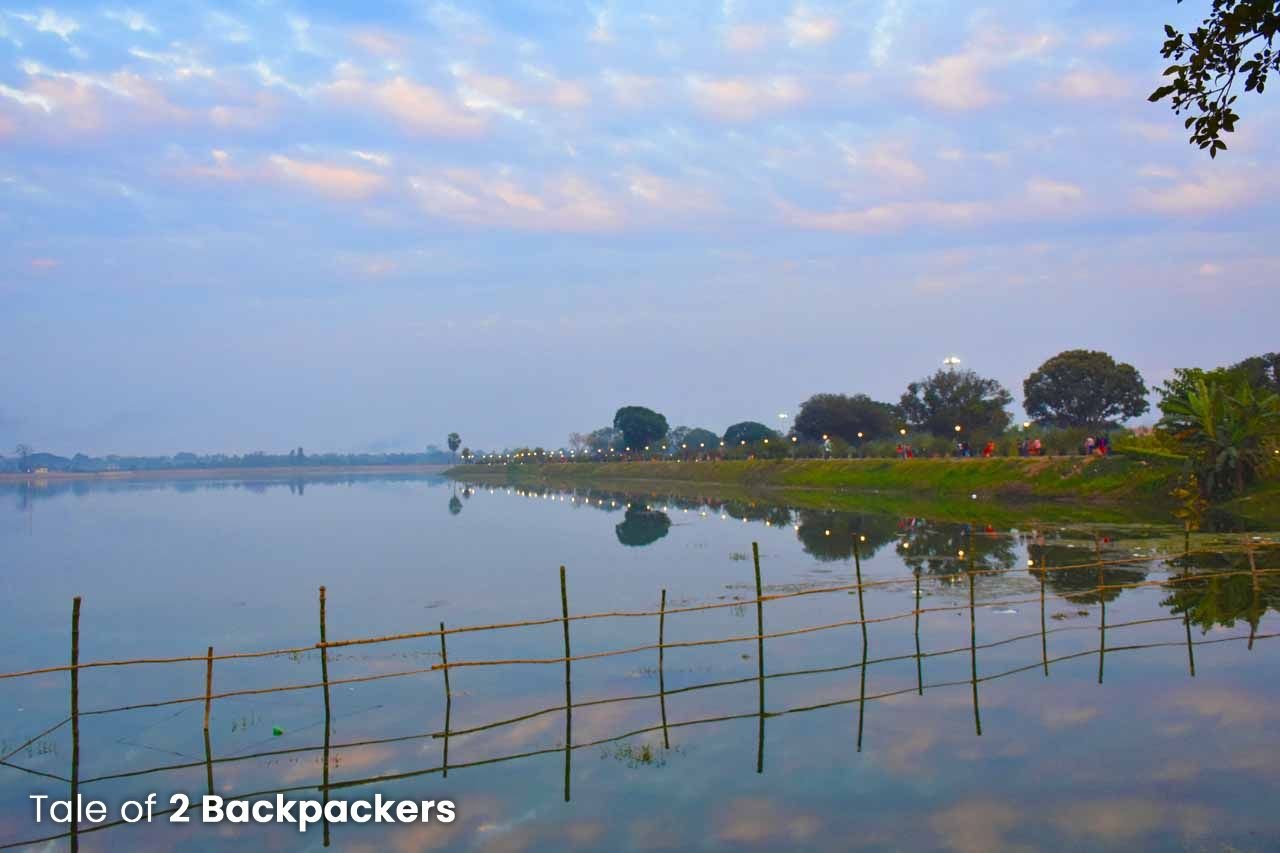
Motijheel is a beautiful horse-shoe shaped lake located about 3 km from Wasifi Manzil. The lake was created on the orders of Nawazish Muhammad Khan, the son-in-law of Nawab Alivardi Khan. He had also built a beautiful palace named Sang-i-dalan along with a gateway and a mosque here. Nothing remains of the palace. Only a part of the mosque remains and it is known as the Motijheel mosque. The grave of Nawazish Muhammad Khan is also placed in the mosque. His widow, Ghaseti Begum lived in the palace after his death. In 1756, Nawab Siraj-ud-Daula took over the mosque, ransacked it and carried great treasures from here with him. He built a similar lake and a beautiful palace known as Hira Jheel on the other side of the Bhagirathi River. Nothing remains of Hira Jheel as well. It was totally destroyed after the death of Siraj.
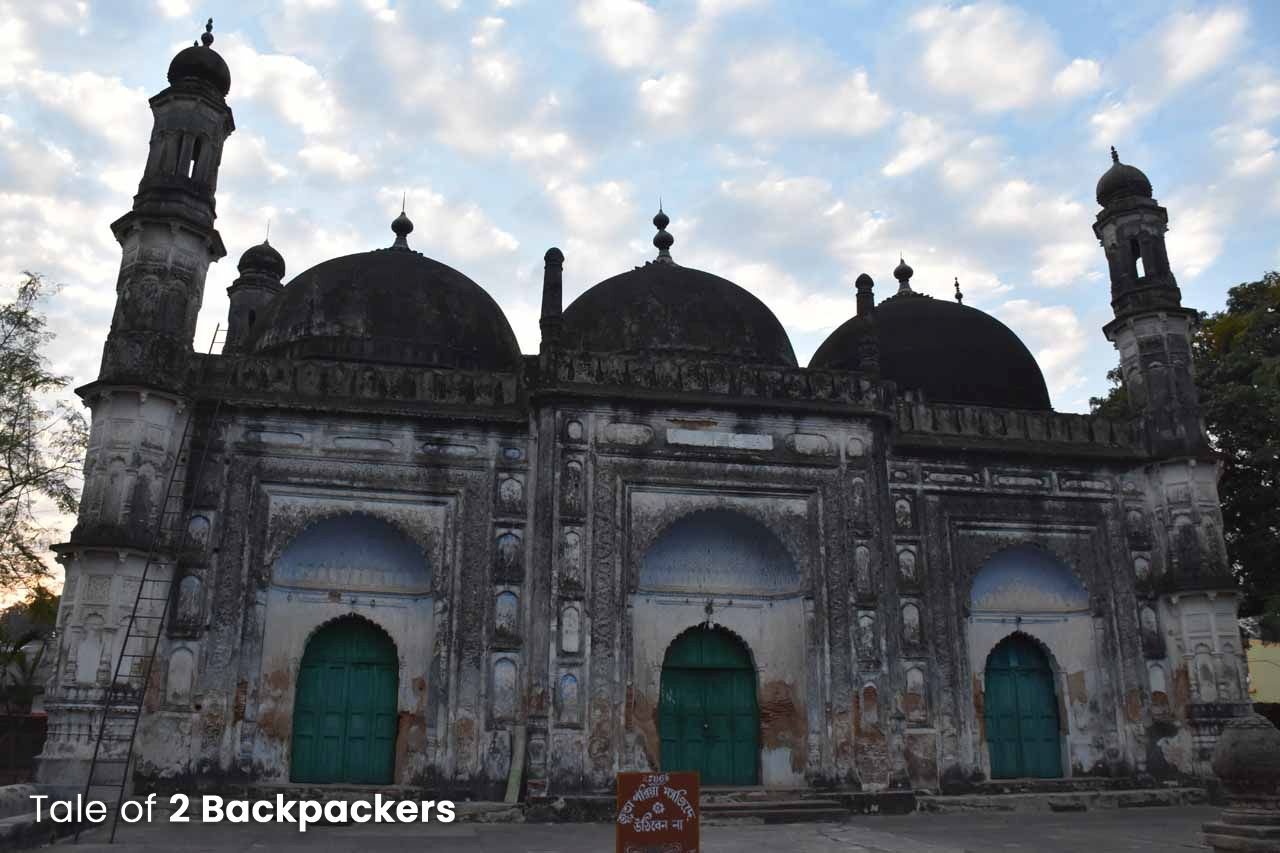
Motijheel is also known as the Company Bagh because of its association with the East India Company. Motijheel served as the residence of Robert Clive in 1765 when he came to negotiate with the Nawab for transfer of Dewani to the East India Company. Warren Hastings too had stayed here during 1771-73.
-
Terracotta Temples of Azimganj
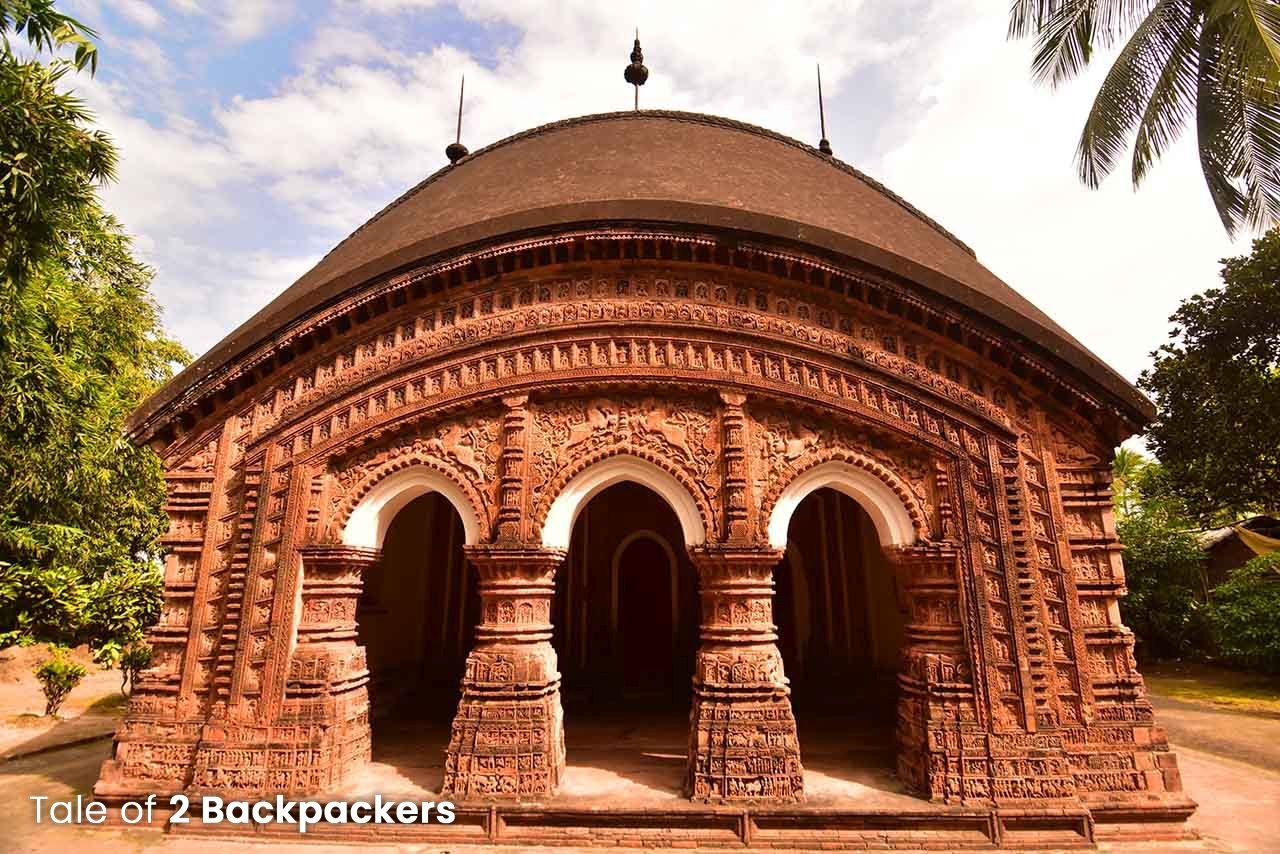
The Baranagar area of Azimganj has some beautiful terracotta temples. These temples were built by the pious Rani Bhabani of Natore (now in Bangladesh) during the 18th century. Rani Bhabani was well known for her philanthropic deeds. She was also a celebrated patron in Kashi (now Varanasi). She had built 380 asylums in Benaras, guest houses and temples. She encouraged Hindu learning and bestowed large endowment for the spread of education. She had built a number of Hindu temples at Murshidabad and Natore. Infact, Azimganj area came to be known as the Kashi of the East, because of her.
Many of the temples do not remain now. But the few that remains at Baranagar gives a testimony of some of the finest examples of Bengal temple architecture and terracotta work. Once in Baranagar, you must visit the exquisite Char Bangla Temple, Bhabaniswar Temple, Gangeswar Jor Bangla Temple and Panchanan Shiva Temple.
-
Khosh Bagh

Khosh Bagh lies on the other bank of the Bhagirathi River. Usually, after your visit to the Lalbagh area, take a country boat from the ferry ghat near Hazarduari to Khosh Bagh or the garden of happiness. At Khosh Bagh lie the graves of Nawab Siraj-ud-daula, his wife Lut-fun-nessa and Nawab Alivardi Khan, grandfather of Siraj. The grave of the Siraj-ud-Daula and Lut-fun-nessa lies inside a mausoleum in a simple manner without any trace of extravaganza.

Khosh Bagh was built by Nawab Alivardi Khan. The garden was later maintained by begum Lutfunessa after the death of Siraj. It is believed that once 108 varieties of roses once bloomed in the garden. There might not be so many left now, but the place is still peaceful and a sense of happiness prevails once you are at Khosh Bagh. The place also has other graves of the Nawab family, many of which have not yet been identified.
-
Cossimbazar Area
Cossimbazar was a bustling port during the heydays of Murshidabad. Cossimbazar was also a fortified area, especially after the Battle of Plassey in 1757. Located less than 10 km from Murshidabad town, Cossimbazar has some interesting attractions. The most interesting place to visit is the Cossimbazar Chhoto Rajbari (Cossimbazar Palace of the Roys). The Roys had settled in Cossimbazar and had made a fortune by trading in silk. The palace has now been converted into a heritage hotel.
The Cossimbazar Boro Rajbari or Cossimbazar Palace is also another interesting place to visit, but it is in ruins now. You can also visit the Dutch and English cemetery, the Armenian Church of St. Mary’s, Byaspur Shiva Temple and the Pataleshwar Shiva Temple.
You will need another day in your itinerary if you want to explore Cossimbazar area.
-
The Jain Temples of Azimganj

Azimganj has a rich history and heritage. The twin cities of Azimganj and Jiaganj were the place where the Rajasthani merchants came and settled down. With them they brought down their own tradition, food and culture and blending with the local culture, a unique community, the Sheherwalis emerged.
The Sheherwalis were Jains by religion and they had built a number of Jain temples around the region. There are nearly 9 Jain temples in the Azimganj area. You can simply walk around or take a Toto (e-rickshaw) and visit these beautiful Jain Temples.
Our Hazarduari – Murshidabad Itinerary
To explore Murshidabad and around, you need at least 2 days at your disposal. 3 days will definitely be better. How you plan your Murshidabad trip depends largely on your choice of accommodation. If you are staying at Cossimbazar, then your trip will start from there and then visit Murshidabad. If you are staying at Murshidabad, then the trip starts there and then you will have the option to visit Cossimbazar area or the Azimganj area according to your interest.
Here we are giving the itinerary that we had followed with the help of Bari Kothi, Azimganj, the only heritage hotel in Murshidabad.
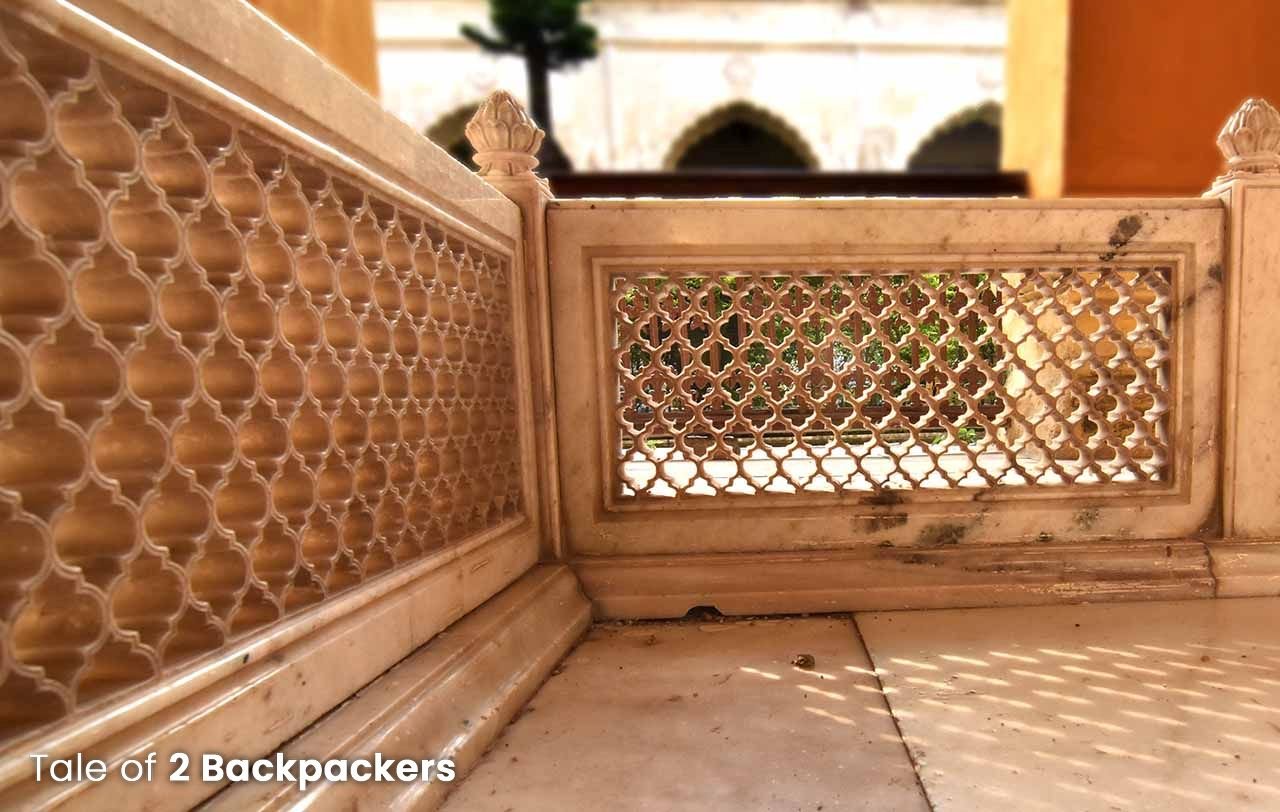
Day 0: Arrival at Bari Kothi
We arrived at Bari Kothi in the dead of night. We had taken the Howrah-Katihar Special and arrived at Azimganj Station at 1.45AM. From there Bari Kothi was about 10 minutes Toto ride.
Day 1: Local sightseeing at Murshidabad
After having a hearty breakfast by the Bhagirathi River, we took a country boat and crossed the river to the other side. We arrived at the jetty near Hazarduari. We explored the Hazarduari Palace complex along with the Nizamat Imambara, Bacchawali Tope, Madina and the Clock Tower. We also saw the Tripaulia gate just outside the Hazarduari Palace.
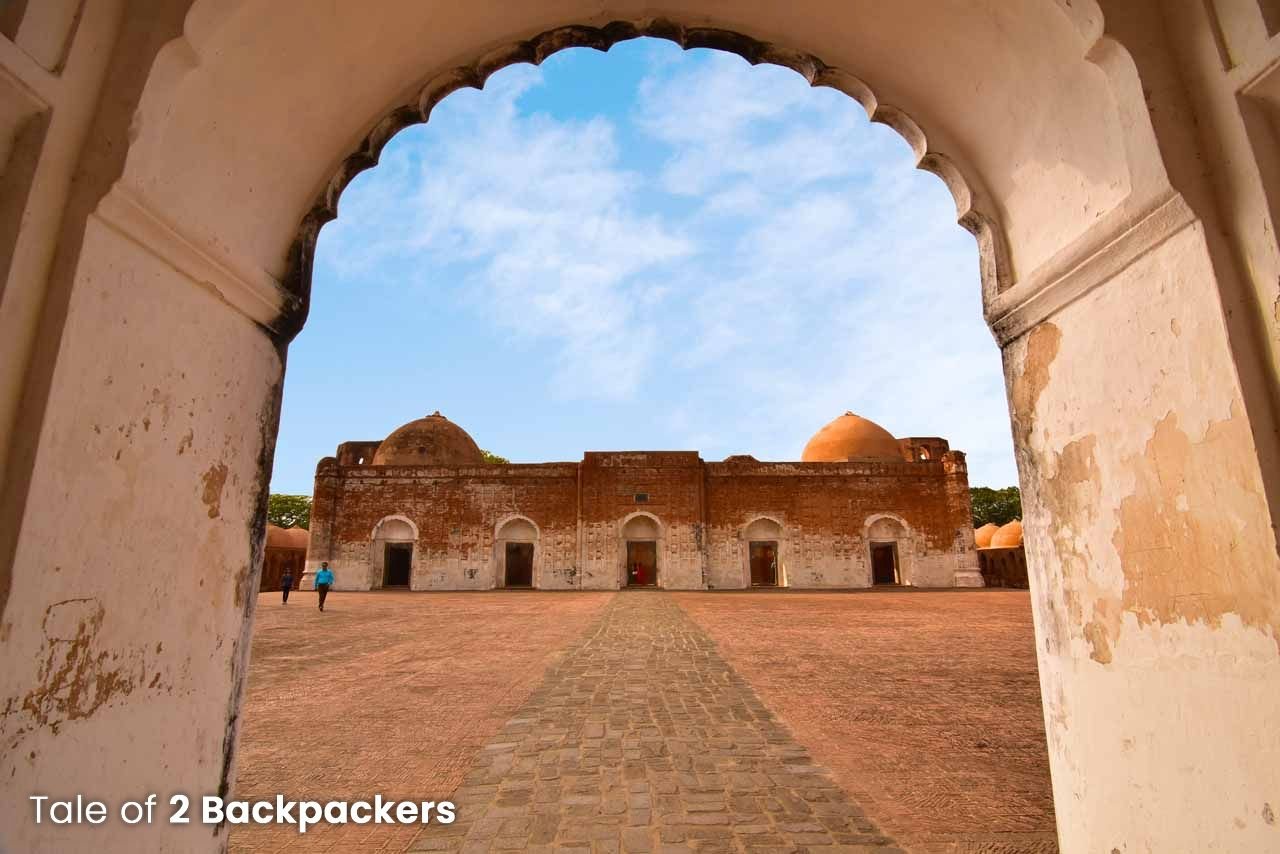
Next, we took an e-rickshaw (Toto) for exploring Murshidabad. You can also take a tonga ride (horse carriage) if you fancy. The next in line was the Katra Mosque, Jahankosha Cannon, Fauti mosque, the tomb of Begum Azimunnisha, Namak, Haram Deori, Jafarganj Cemetery, Nashipur Rajbari, the House of Jagat Seth and the Kathgola Gardens. After that, we returned back to Bari Kothi.
If you start early, then you can also cover Wasifi Manzil and also visit Khosh Bagh on the other side of Bhagirathi. We were a bit late and so had to miss Khosh Bagh this time. We had, in fact, visited Khosh Bagh on our previous visit and after that also made our way to Motijheel. So if you have enough time, you can put all these in one day itself.
In the evening, a cultural performance was arranged by our hosts.
Day 2: Sightseeing at Azimganj and Jiaganj Area and Return to Kolkata
We started early with and went for Azimganj Heritage walk. We visited the Jain Temples in the area and a couple of old mansions of the area. We visited the Mansion of the Nowlakhas and the Singhi Mansion.

After breakfast, again we took the boat and visited Baranagar to explore the terracotta temples. After that, we again crossed the river by a local ferry to Jiaganj to visit the Tantipara. This is the place where the famous Murshidabad silks are weaved. After seeing how the threads spin themselves into exquisite sarees, we returned back to Bari Kothi. After having our lunch, we started for our return journey to Kolkata.
This was the itinerary we had followed. If you have one more day in hand, you can visit Cossimbazar area as well.

How to reach Murshidabad
The best way to reach Murshidabad from Kolkata is by train. The distance is about 200 km by road. There are a number of trains available from Howrah, Sealdah and Kolkata Station.
The best bet would be to take the Hazarduari Express that leaves Kolkata Station at 6.50AM and reaches Murshidabad Station at 11.10 AM.
Alternatively, you can also take the Ganadevata Express from Howrah at 6.05AM and reach Azimganj Station at 12.15PM.
You can check the train timing at Indian railway website.
Where to stay in Murshidabad
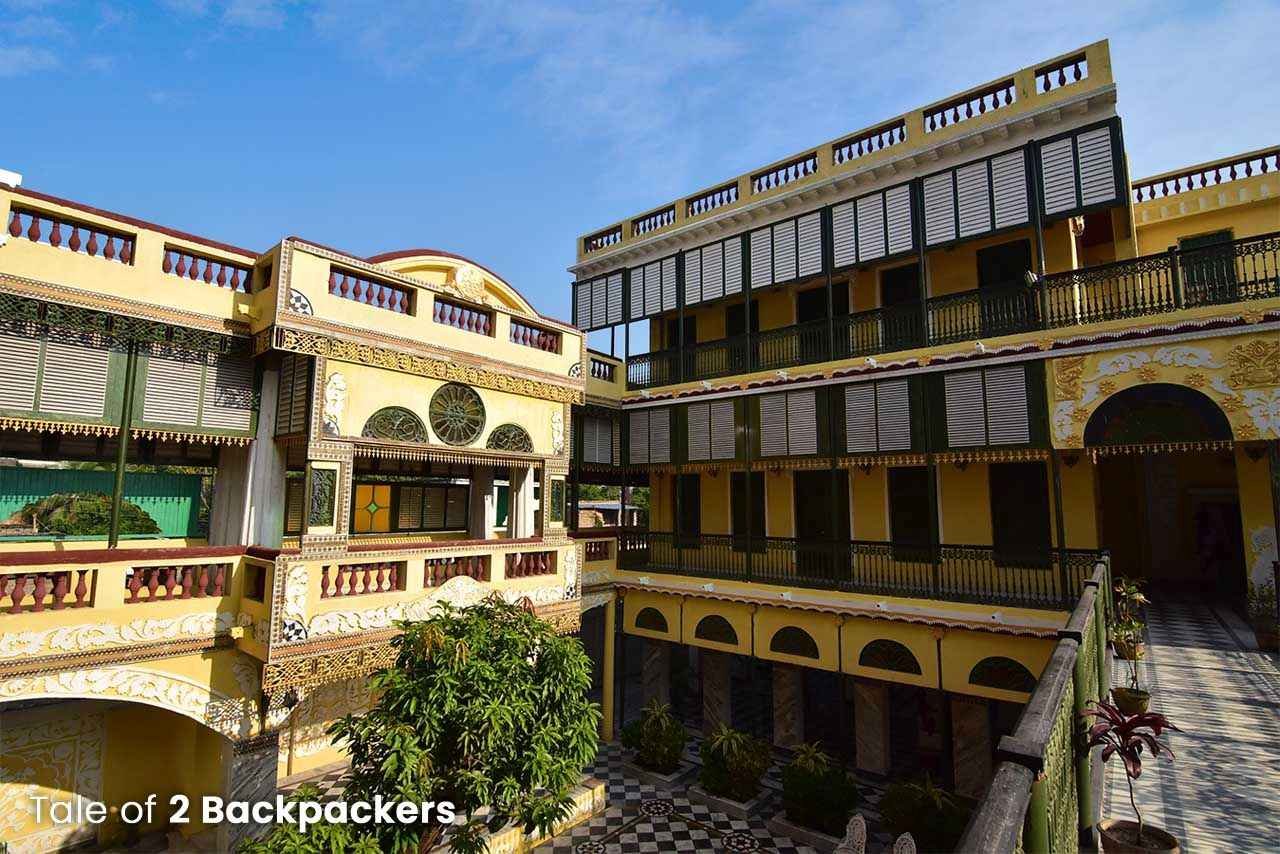
There are a number of hotels in Lalbagh area of Murshidabad as well as near Murshidabad Station. But all these hotels are in the budget category and do not expect proper service in these hotels. The best budget option to stay is the Bahrampur Tourist Lodge by the WB Tourism.
If you want to experience heritage and luxury stay in Murshidabad, then Bari Kothi will be your destination. This boutique luxury hotel located in Jain Patty, Azimganj is a 250 years old property now renovated to provide utmost comfort and a royal experience to their guests. They provide full package to their guests that include stay, food, local tour and cultural experience. For booking, send them a mail at info@barikothi.com
Best Time to visit Murshidabad
The best time to visit Murshidabad is between November to February when the weather will remain cold. At Murshidabad, you have to roam around a lot and a cool weather will be an advantage.
Mangoes in Murshidabad are also quite famous. So if you want to visit during the mango season, then late May to June is the best time.
A few more pictures of Murshidabad
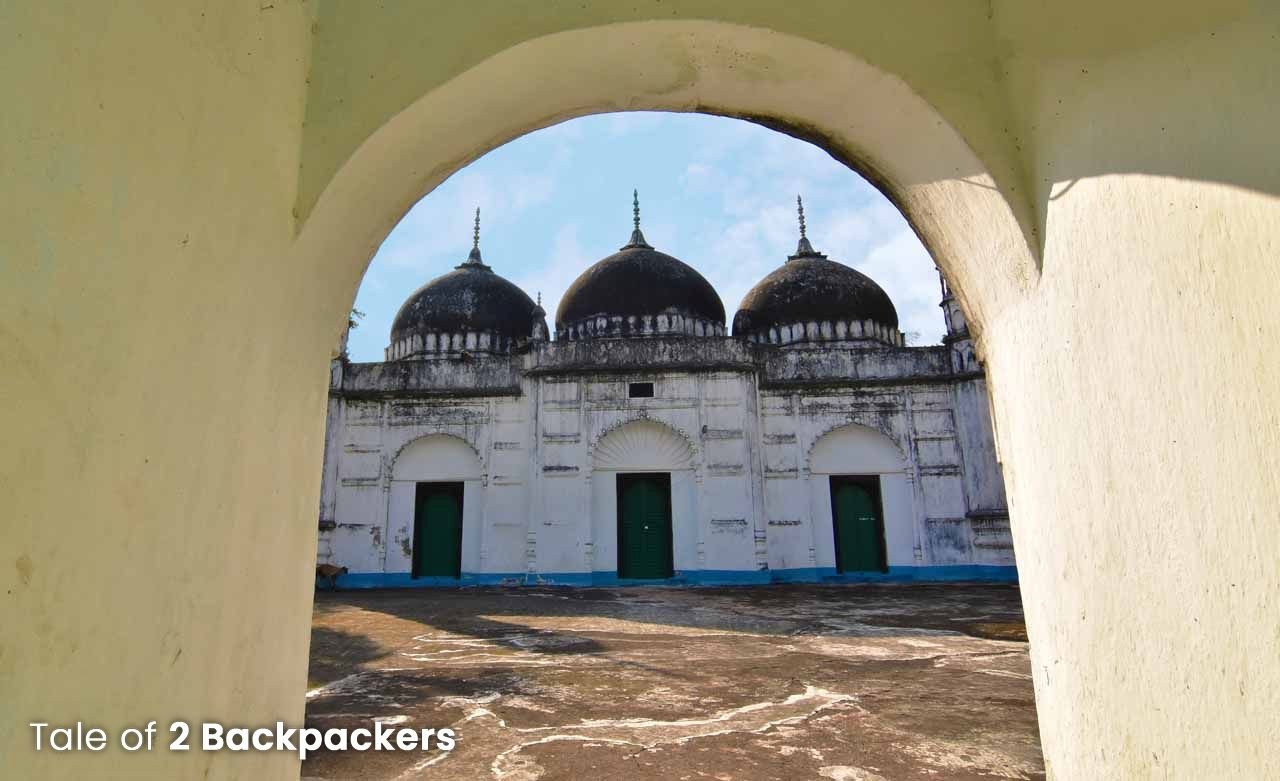





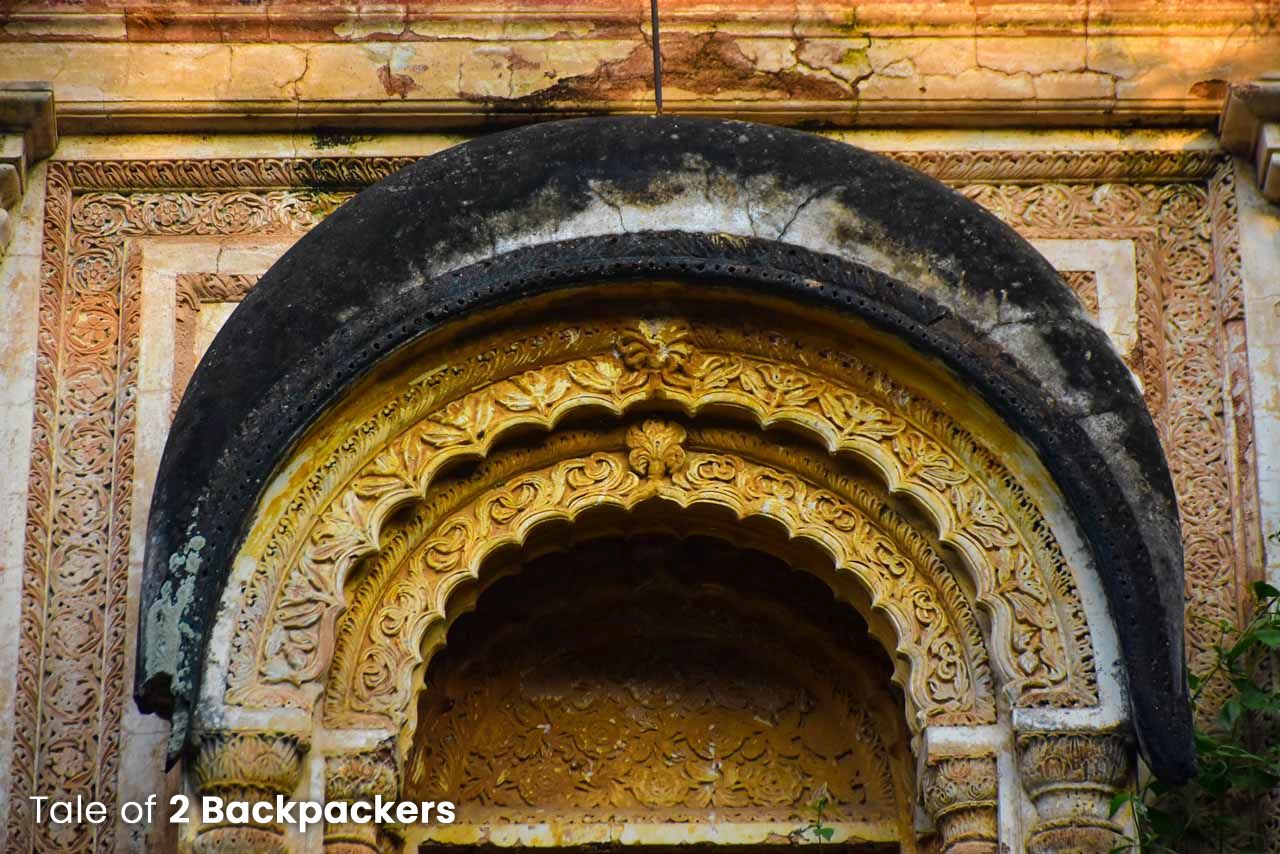


Murshidabad is a beautiful place, only if you wish to explore it and listen to its tale. Hope you liked the post. Please let us know your thoughts by commenting below. Please share it with others.
Pin it for a later read!
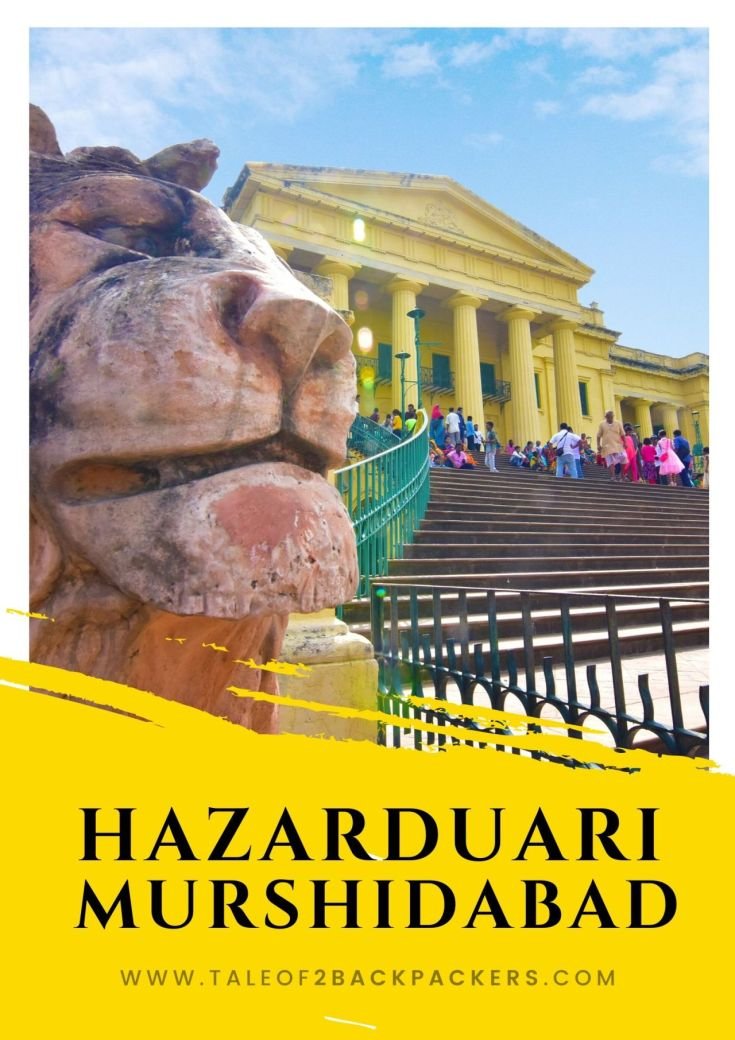
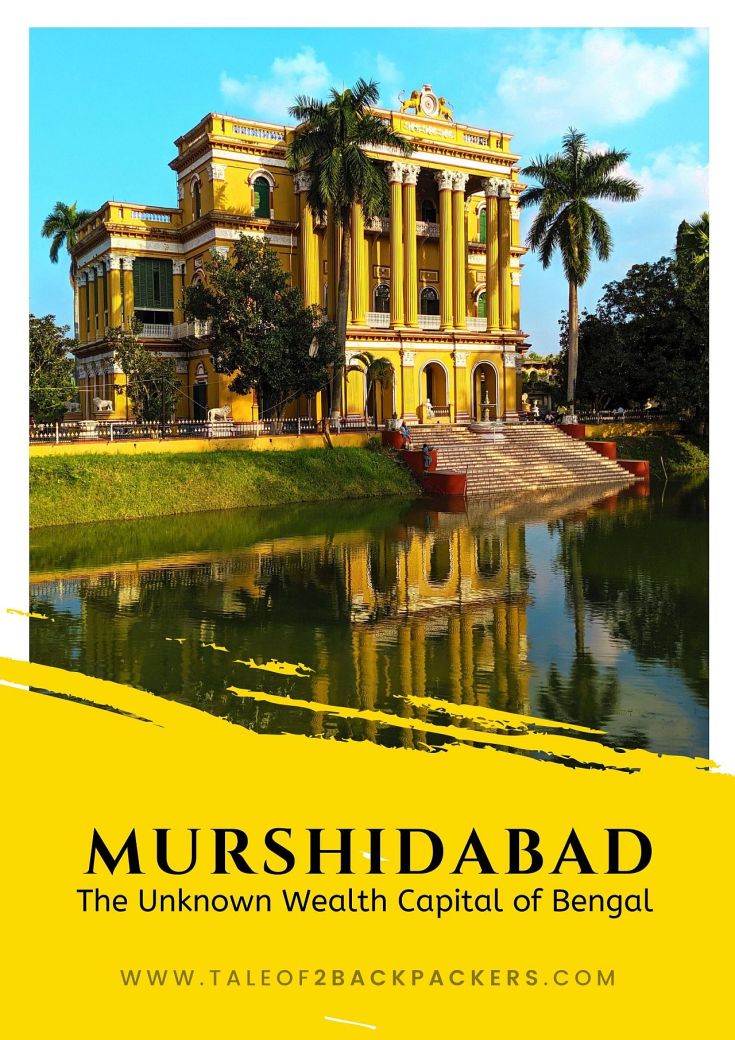




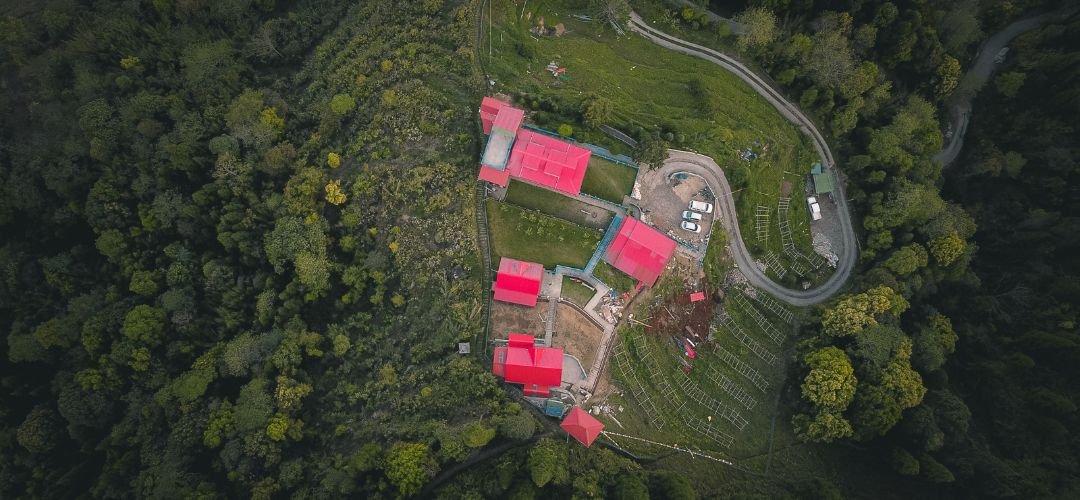


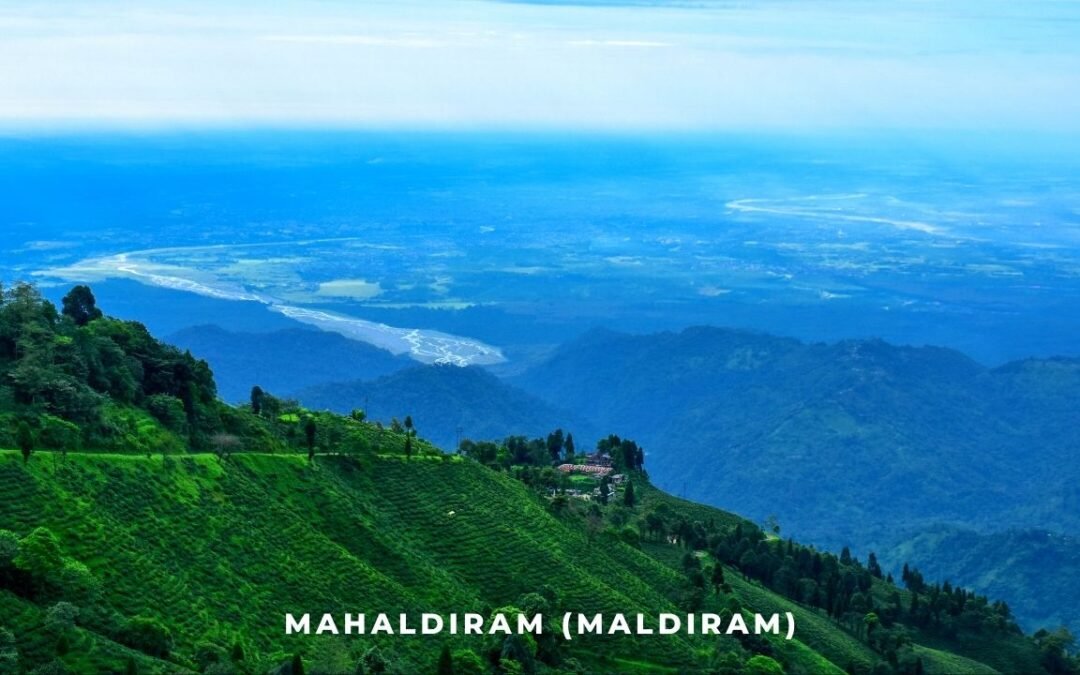
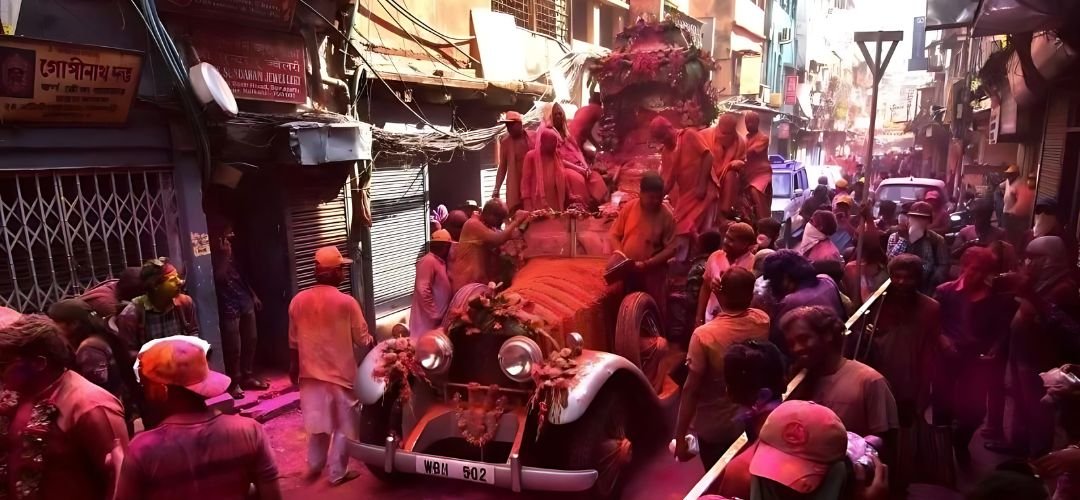
Brilliant would be an understatement. I would like to connect with you to know some details. Is there any email address you can provide where I can contact you.
Thank you so much. Please connect with us at info@taleof2backpackers.com
Wonderful writeup with details n amazing photos.
Thanks.
Thank you so much, Tanushree.
The pictures were amazing. It tells us about the glory of the past. Would love to visit the place.
Thank you so much Madhusree for the kind words. Hope you visit there soon!
Such neat detailed writing!!
Thank you so much! Glad you liked it!
Thank you Agnimitra for such a wonderfully informative piece. I revisited the place of my boyhood days long back in the early fifties.
Thank you so much for this lovely comment. It definitely brought a smile! 🙂
Thanks to you both. You really enhanced my thirst to visit Murshidabad.
Thank you so much for your kind comment. I am sure you had a wonderful trip.